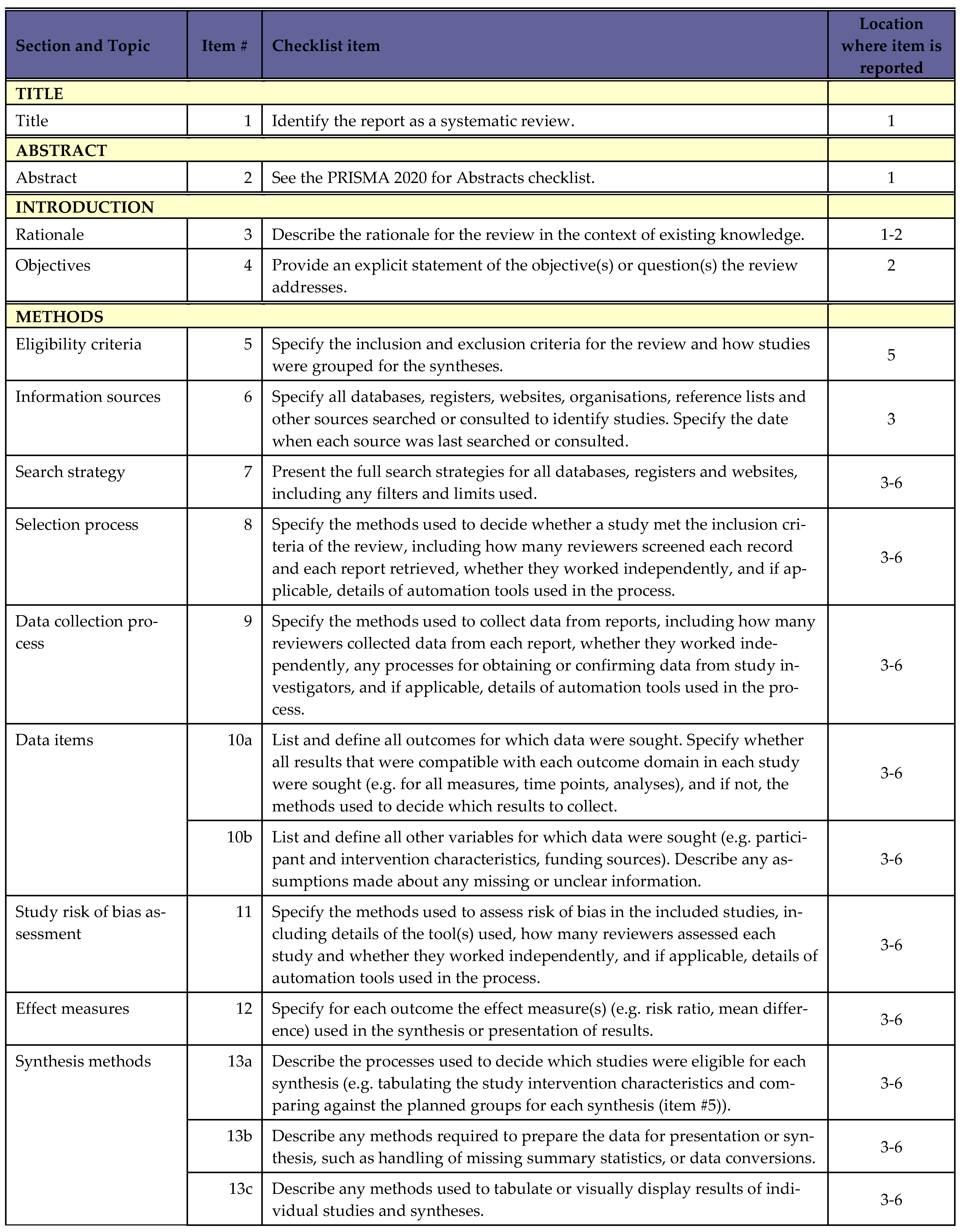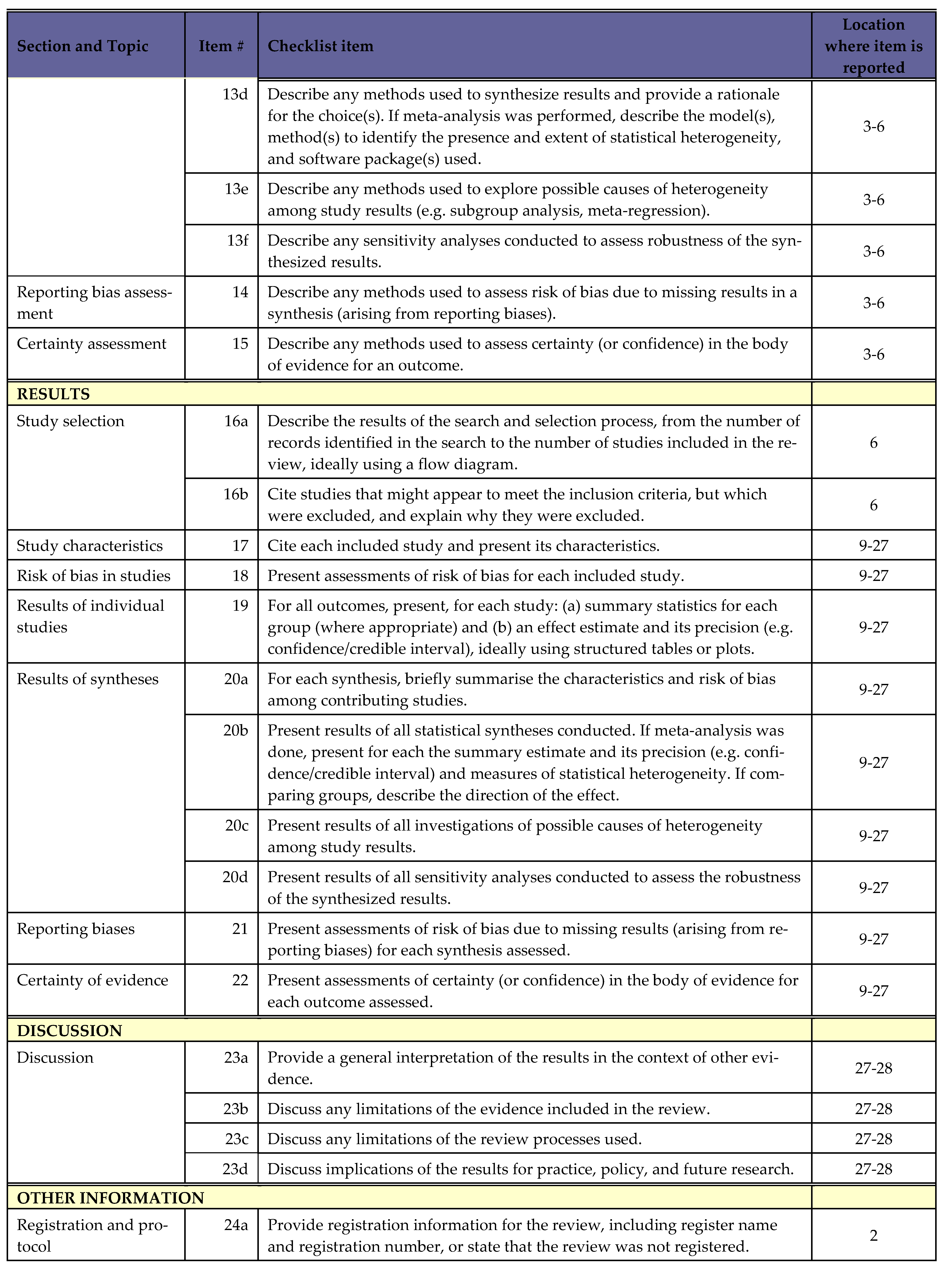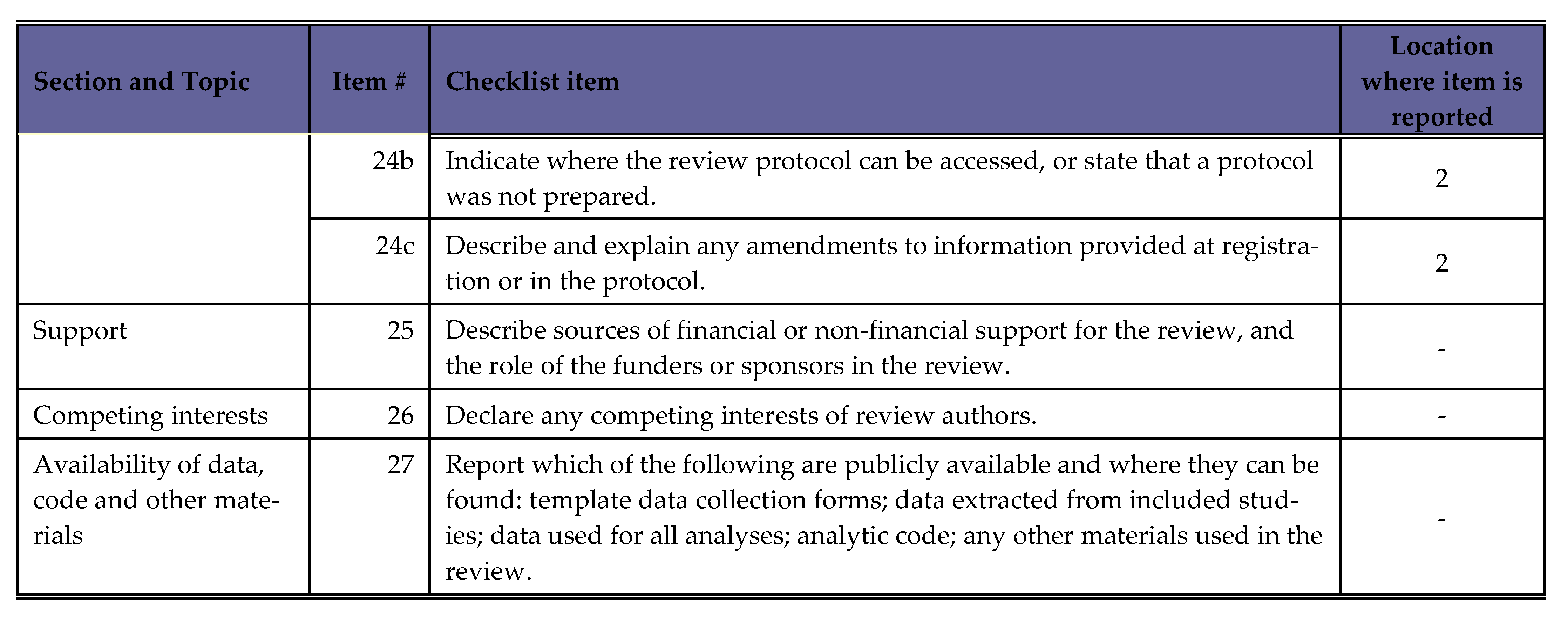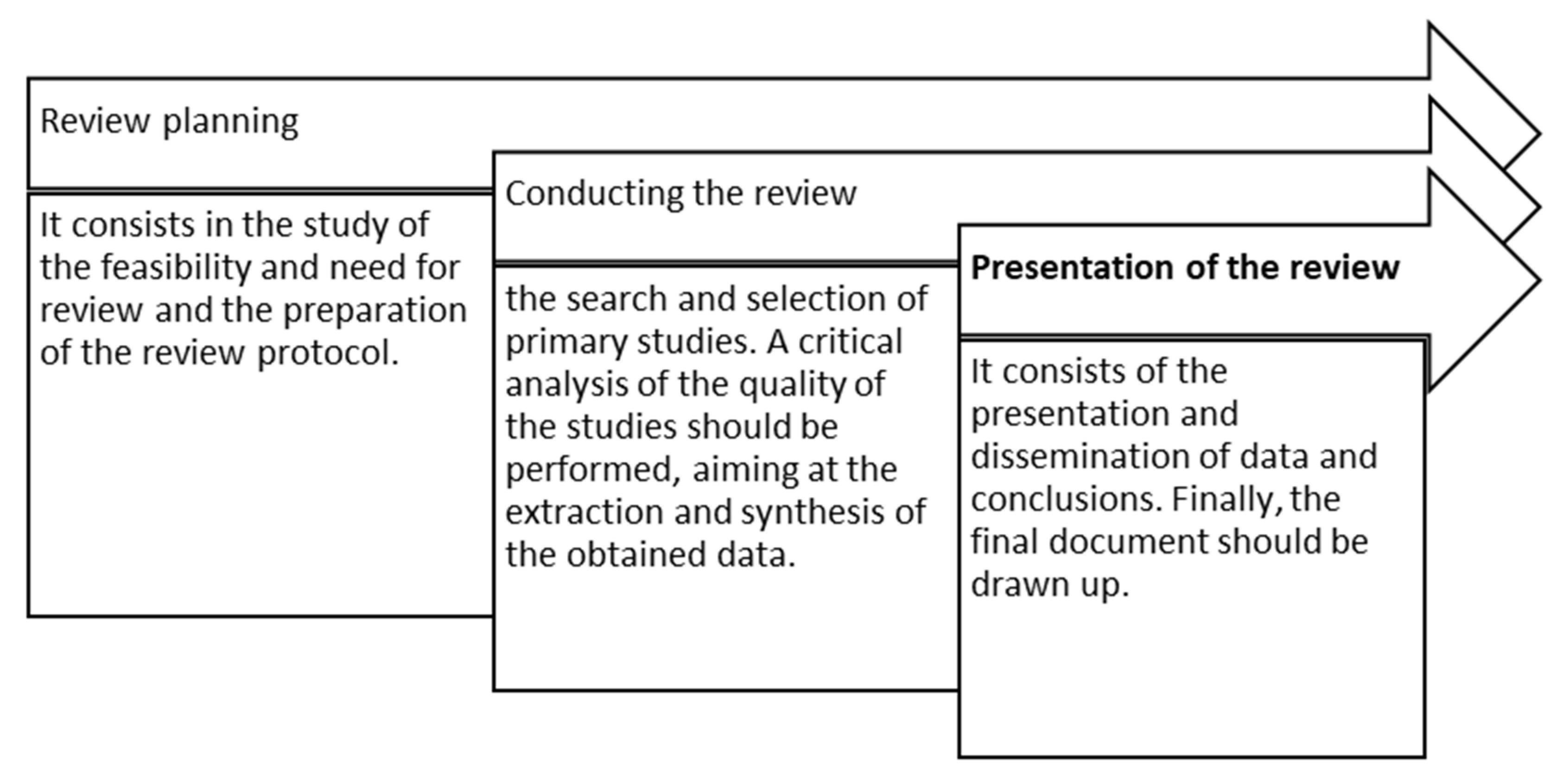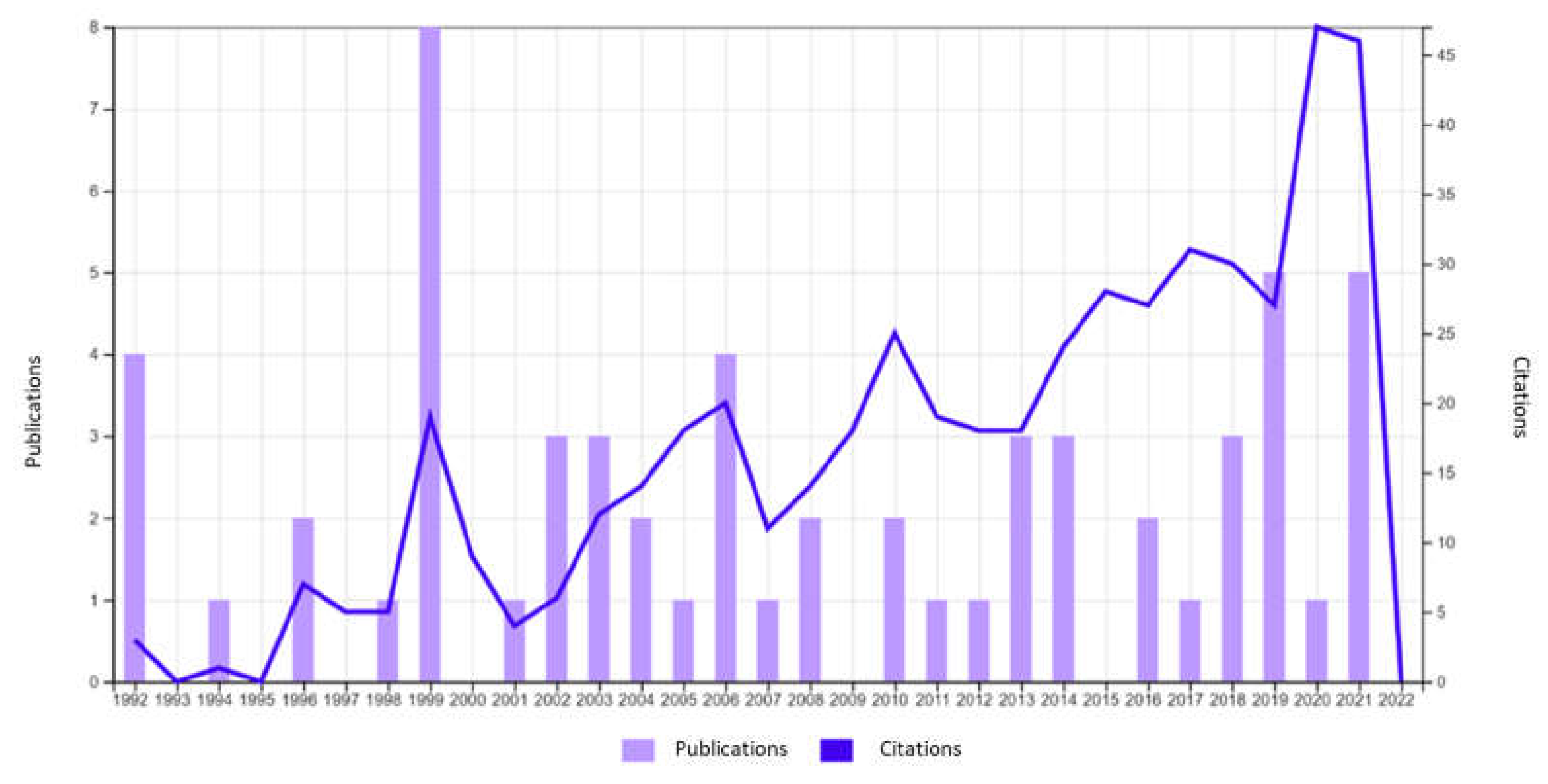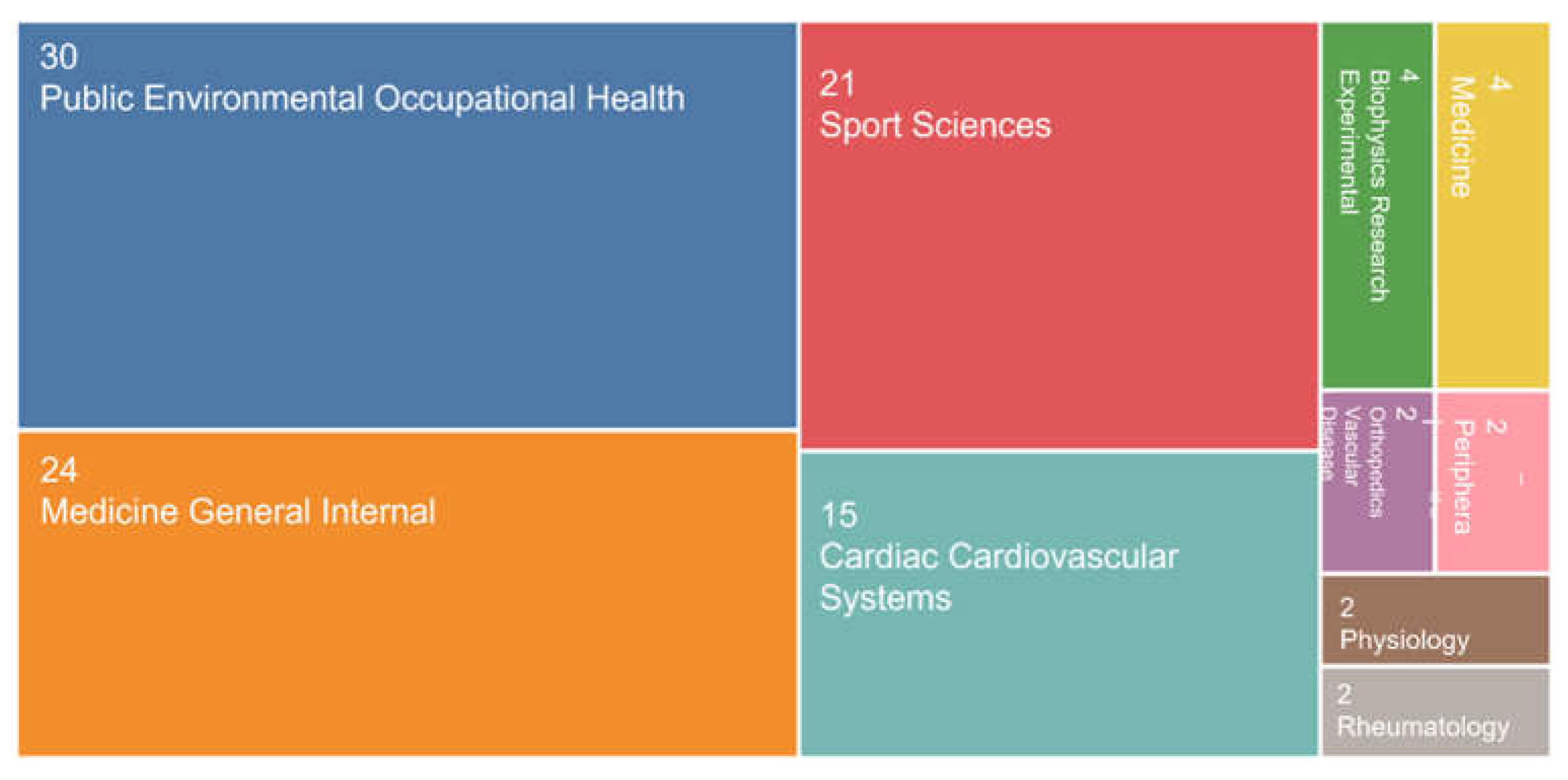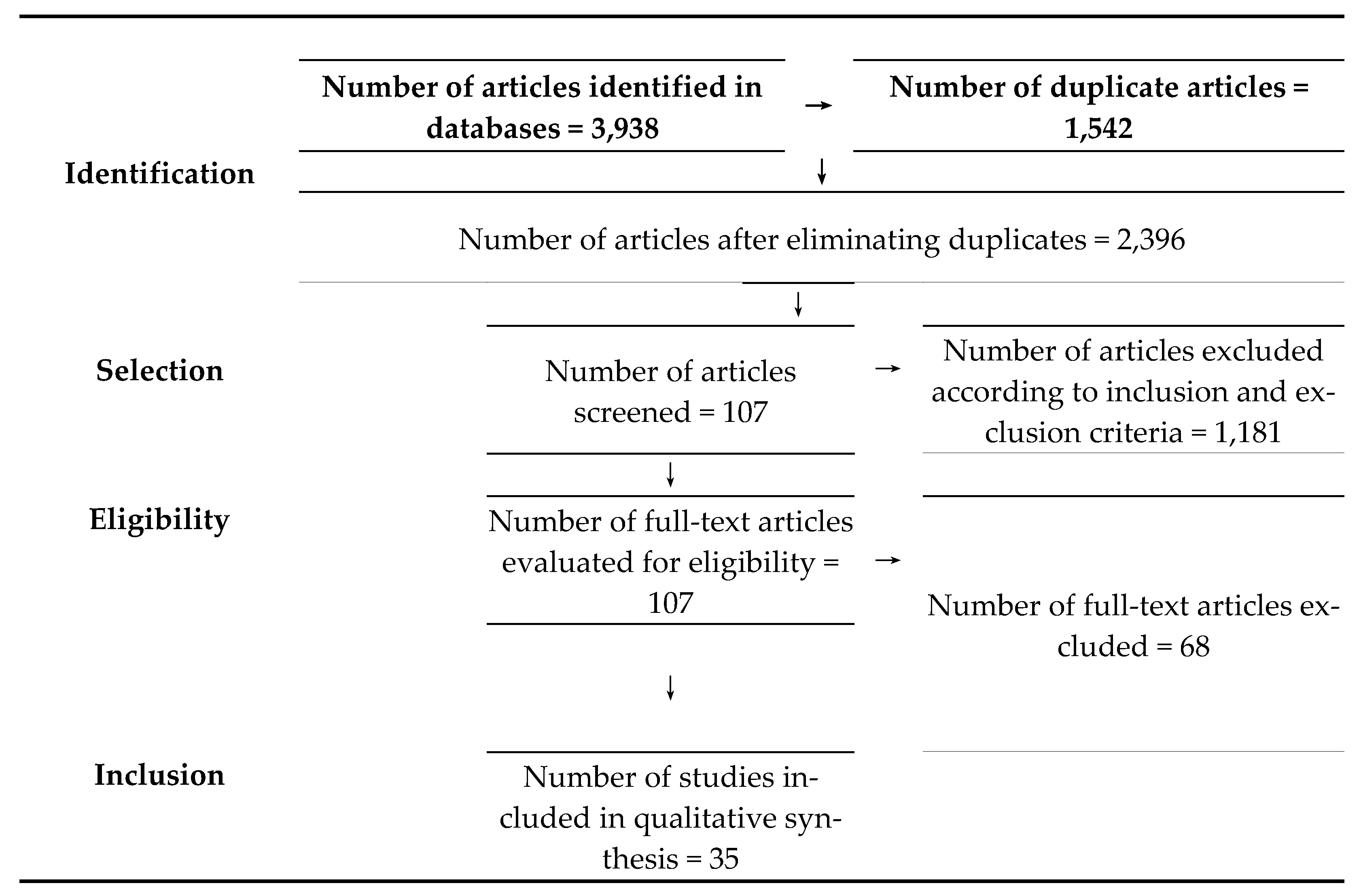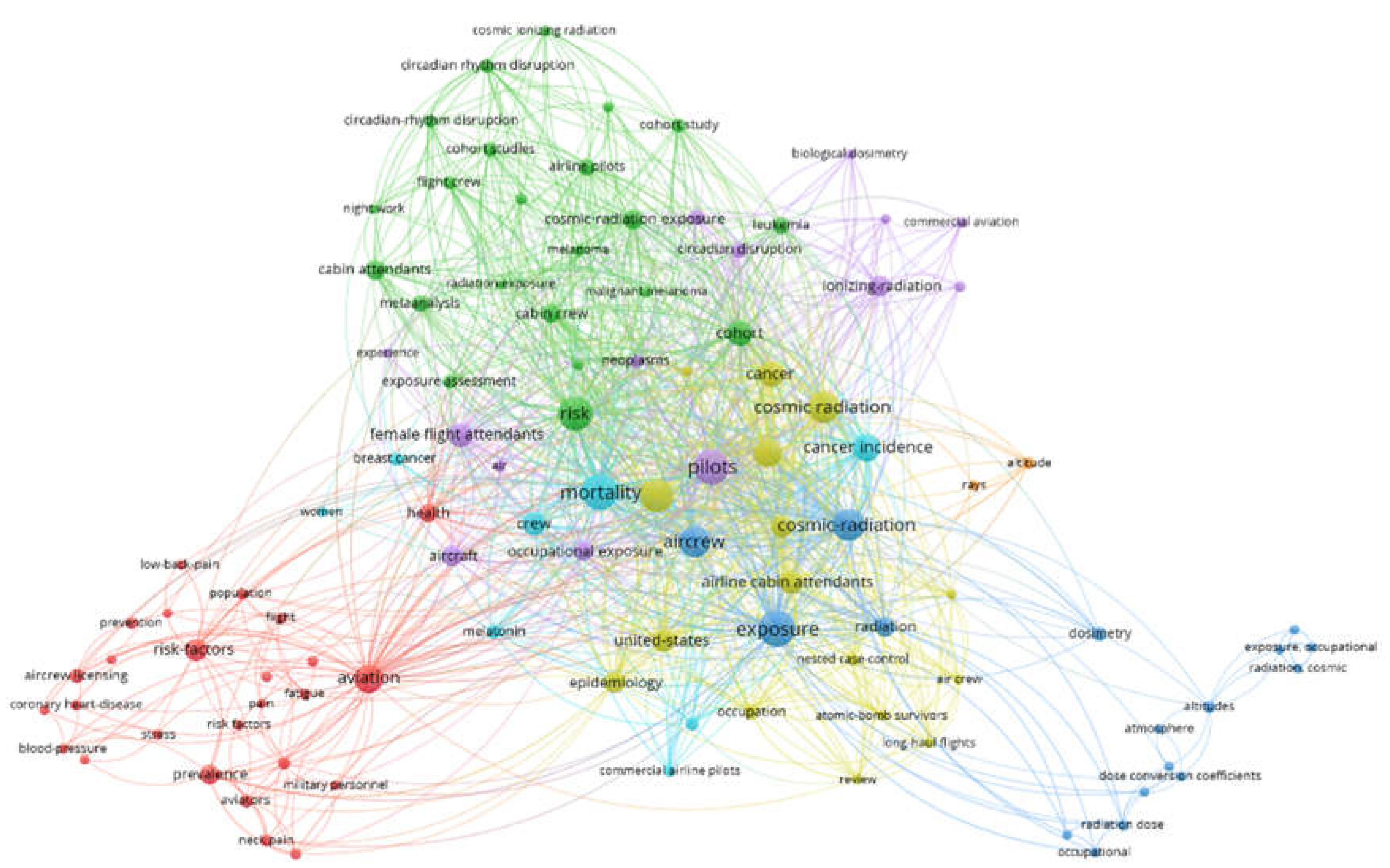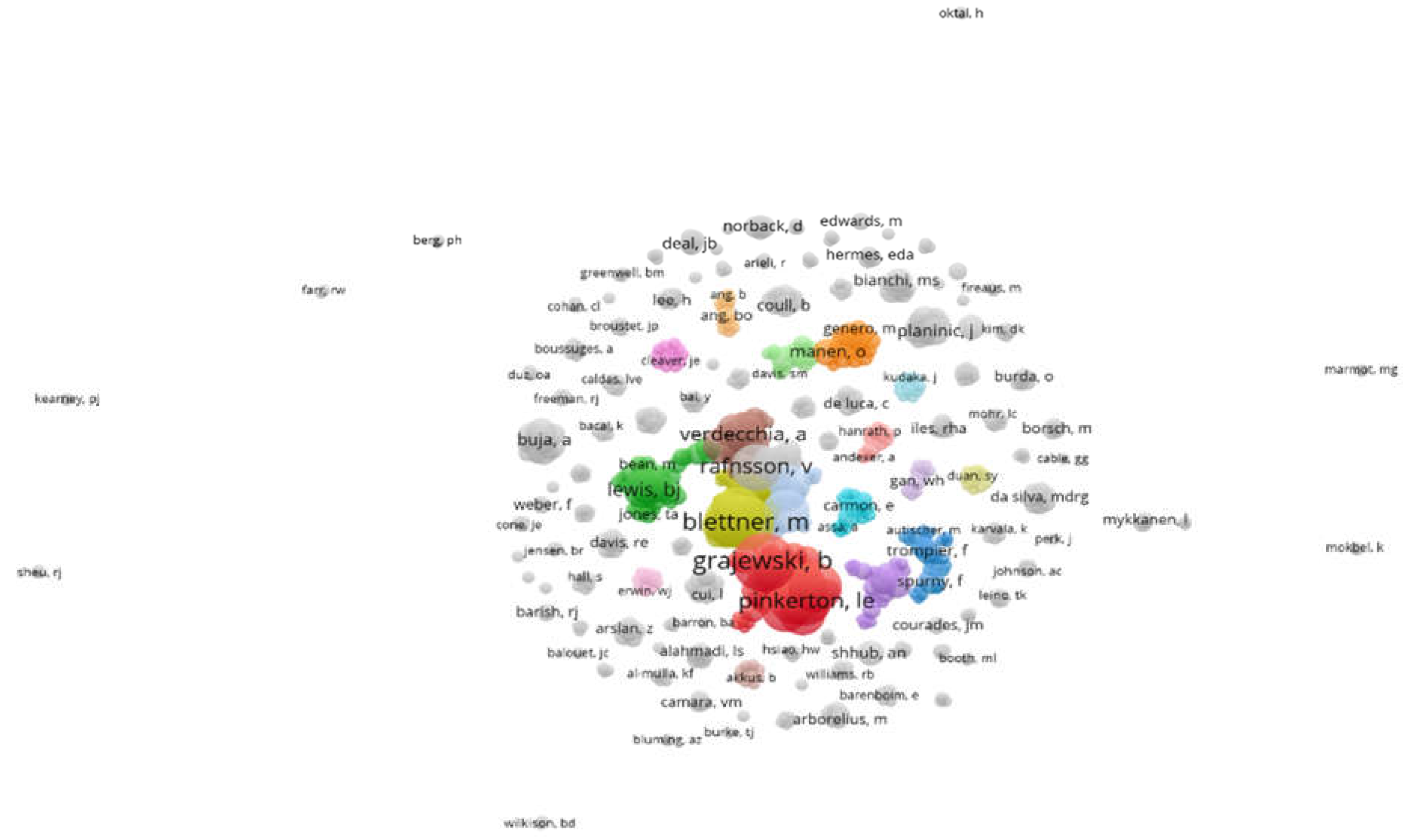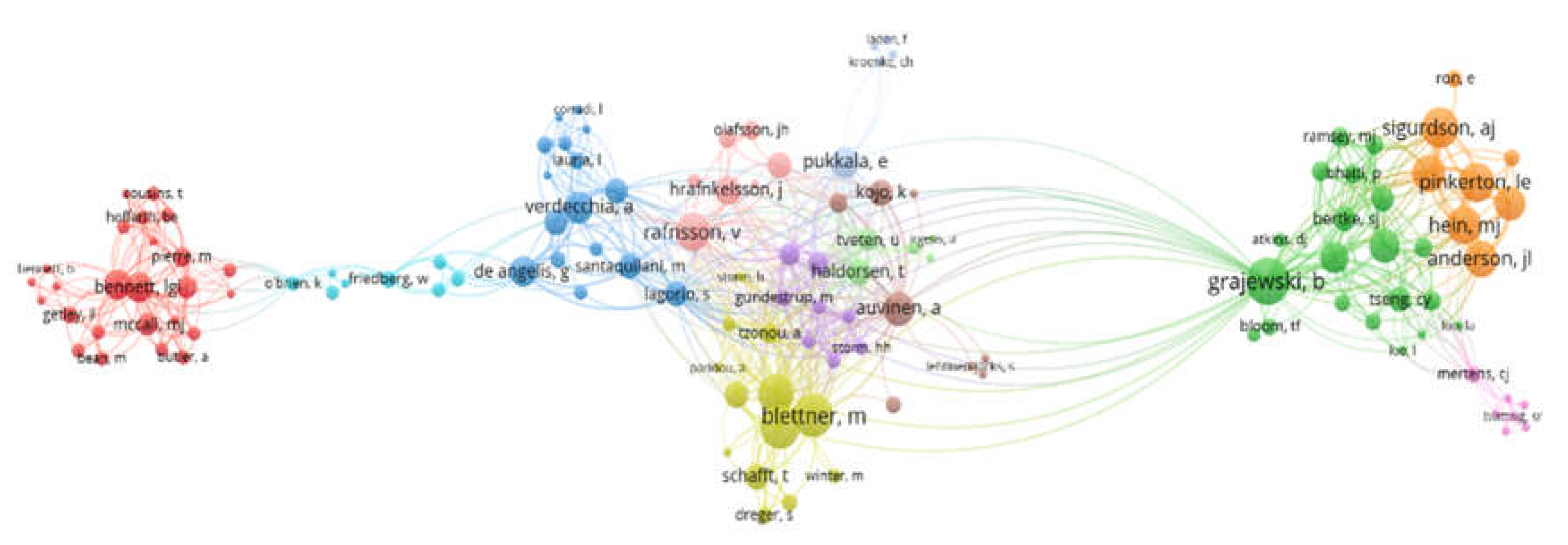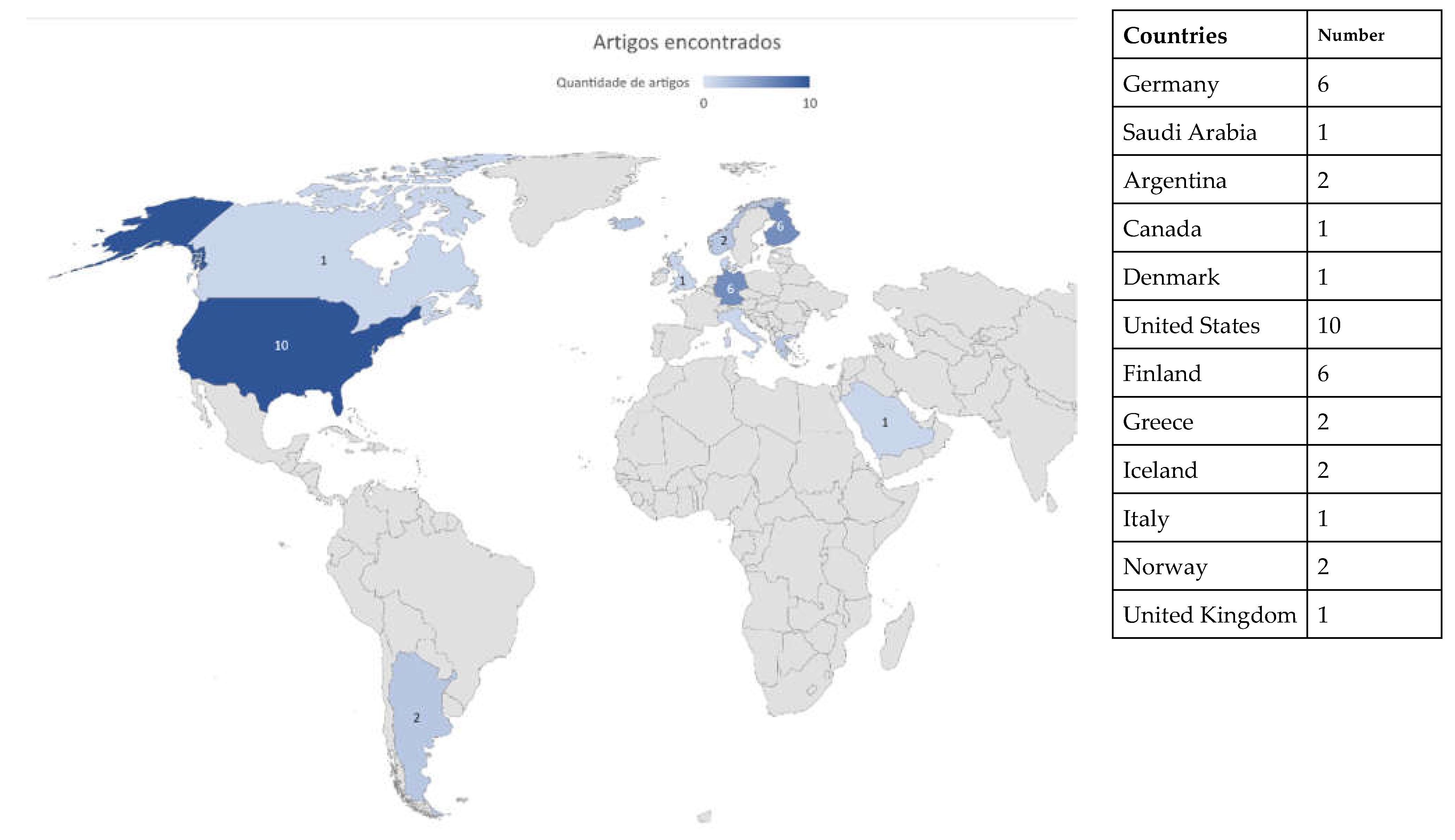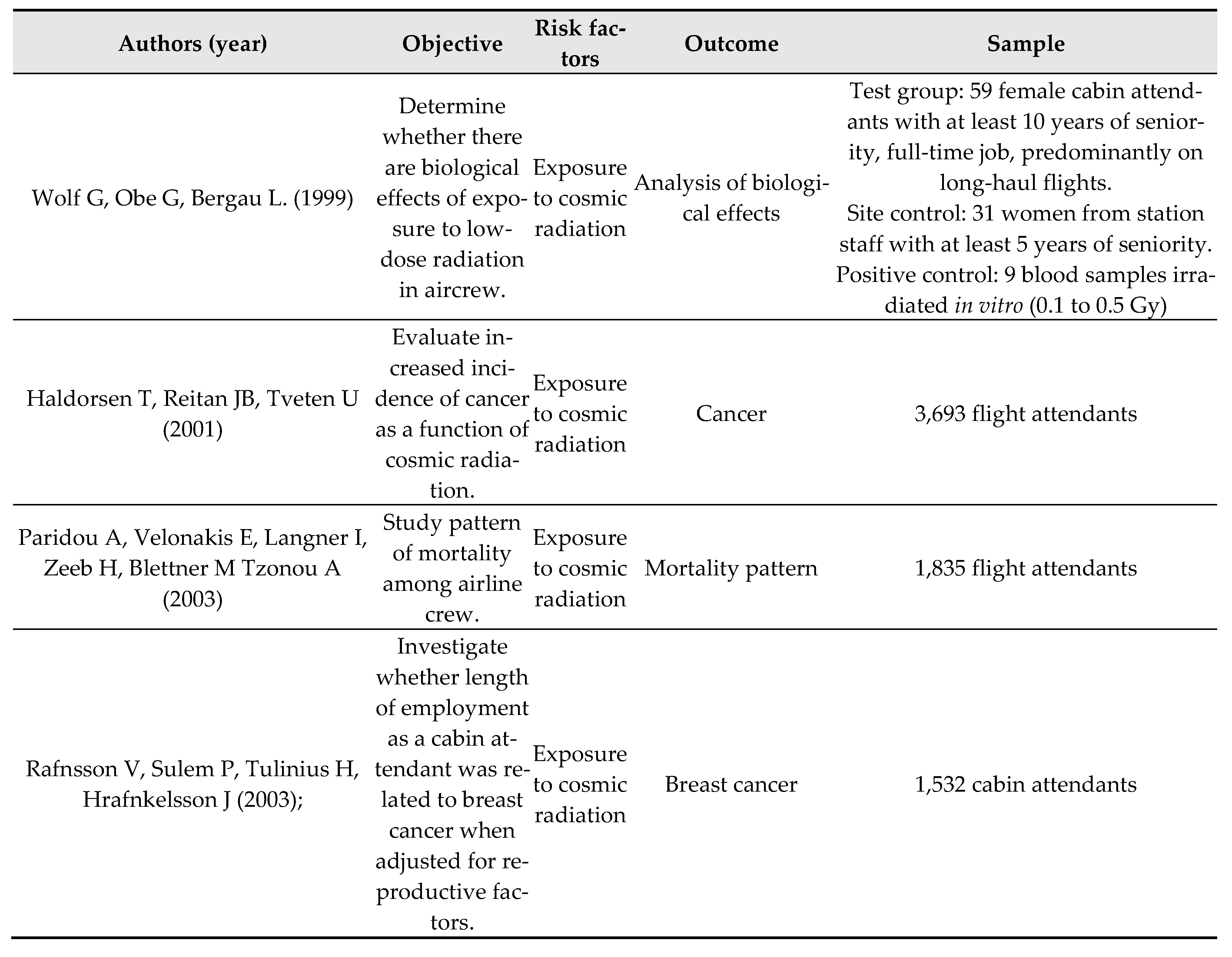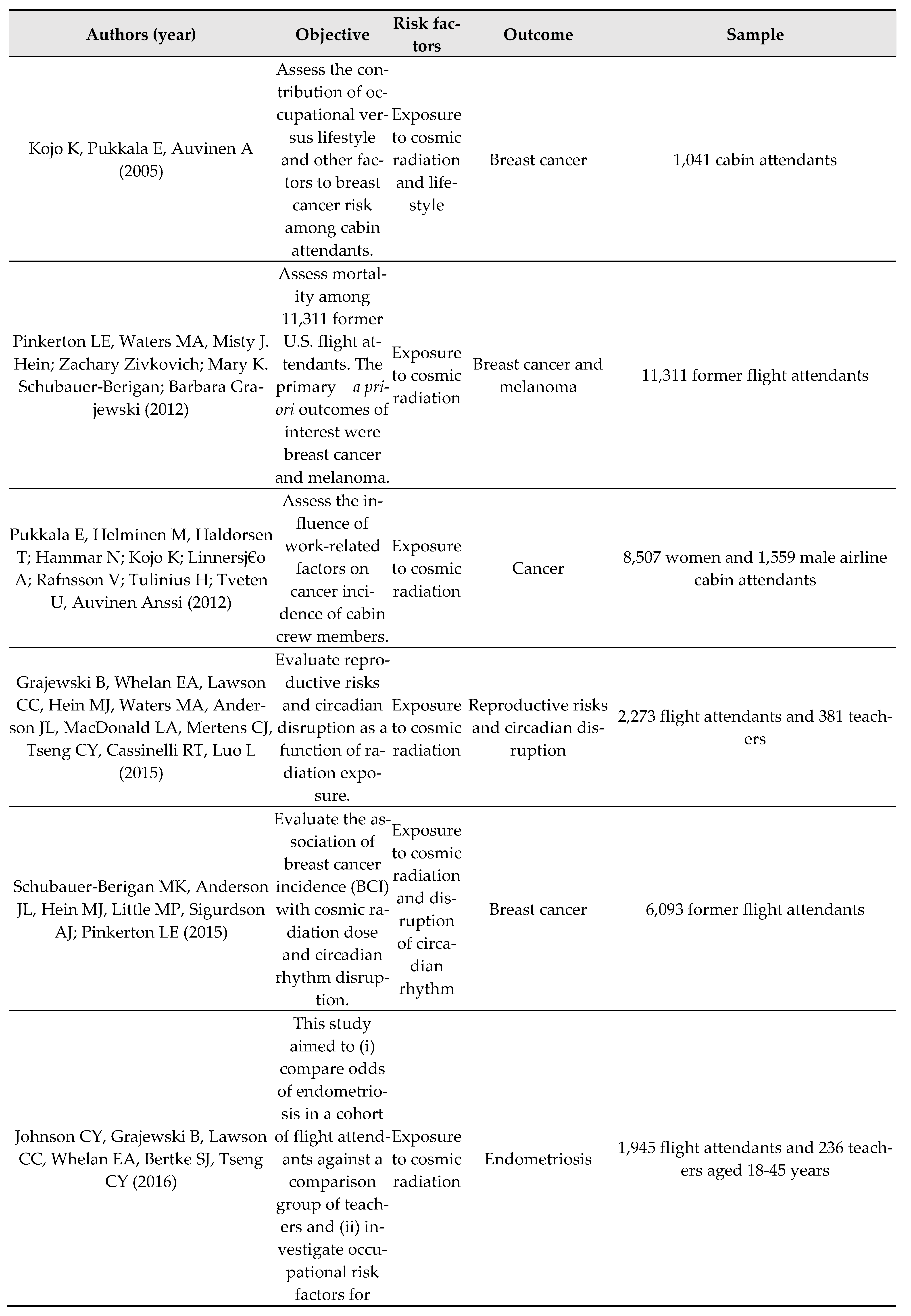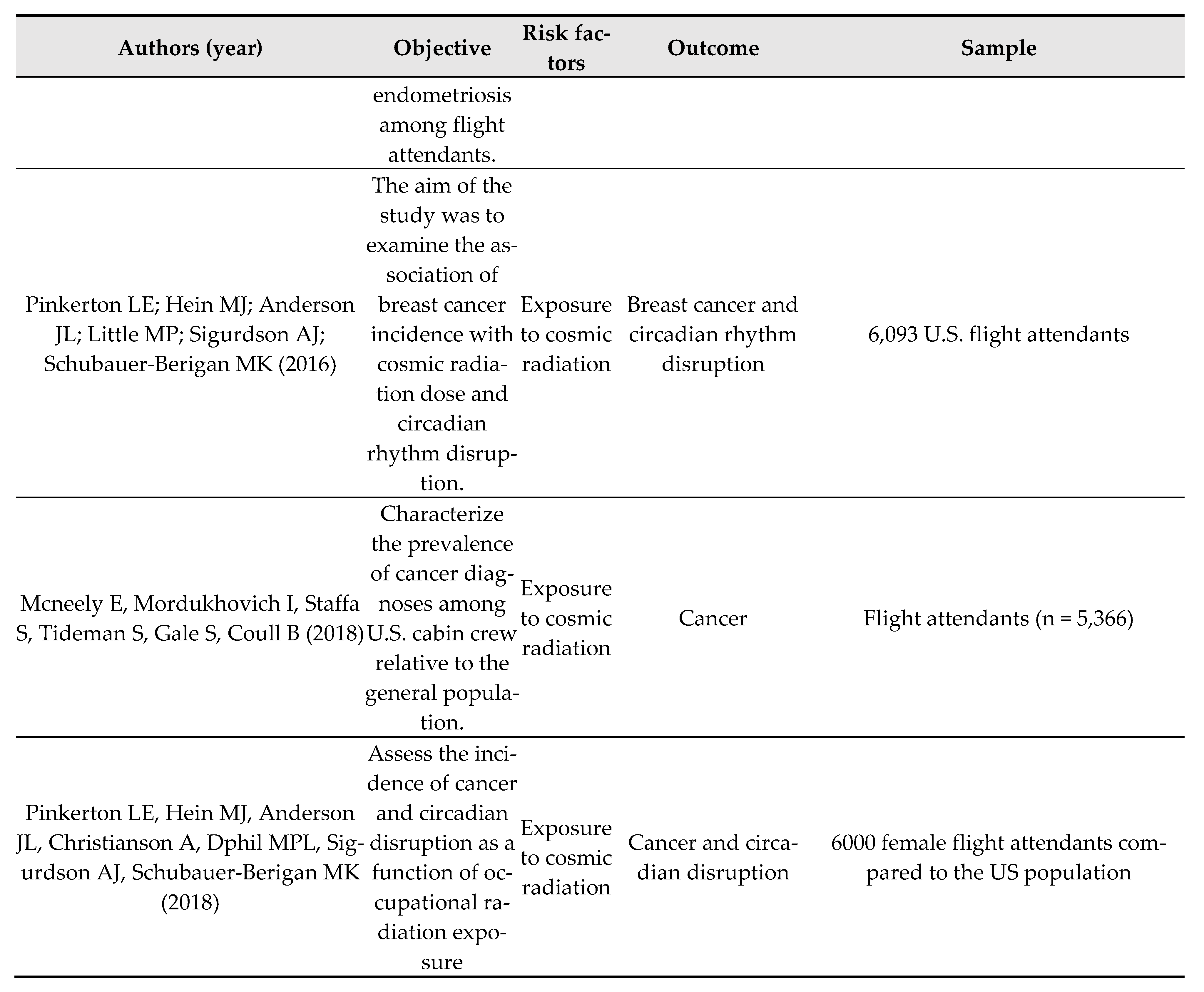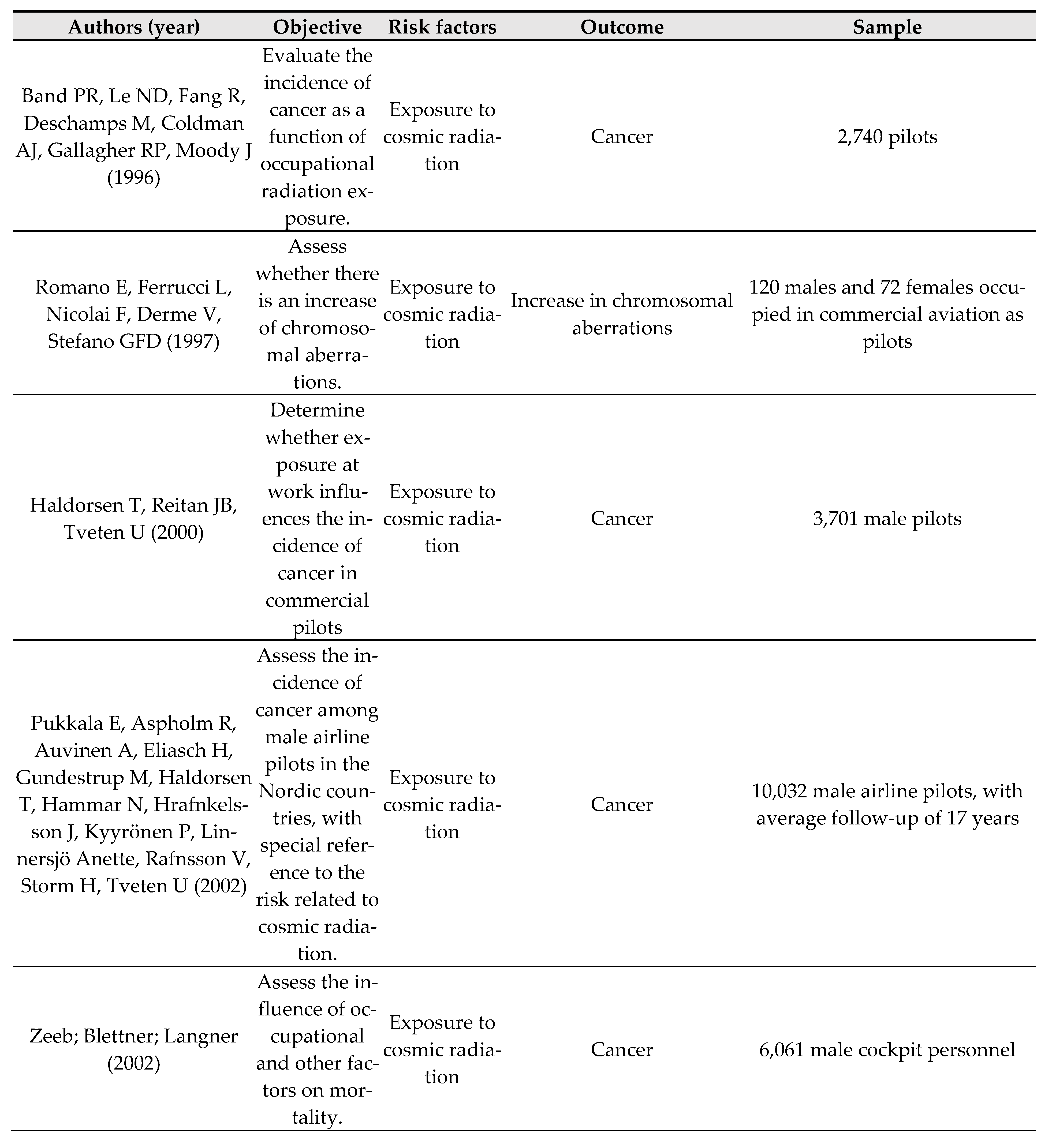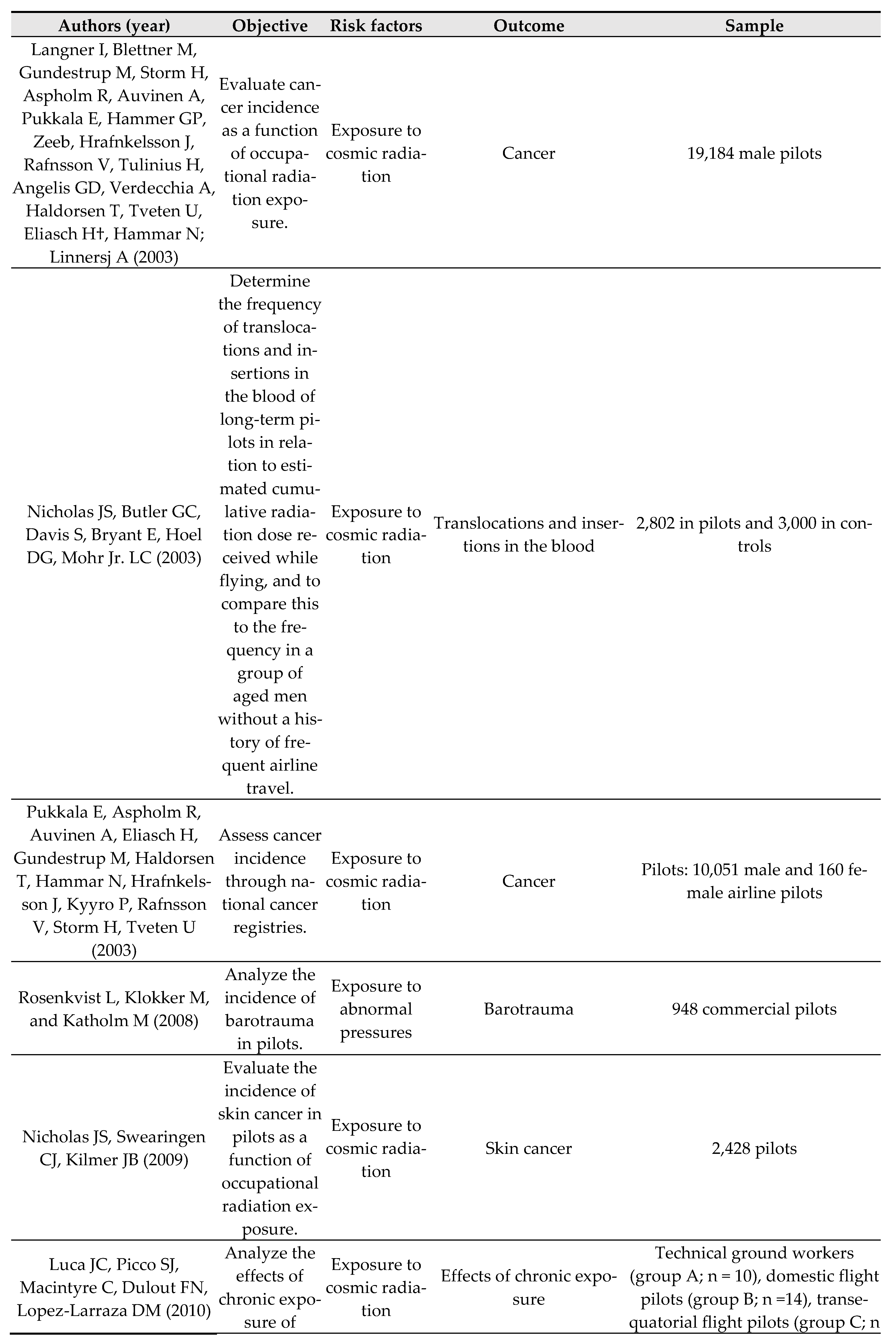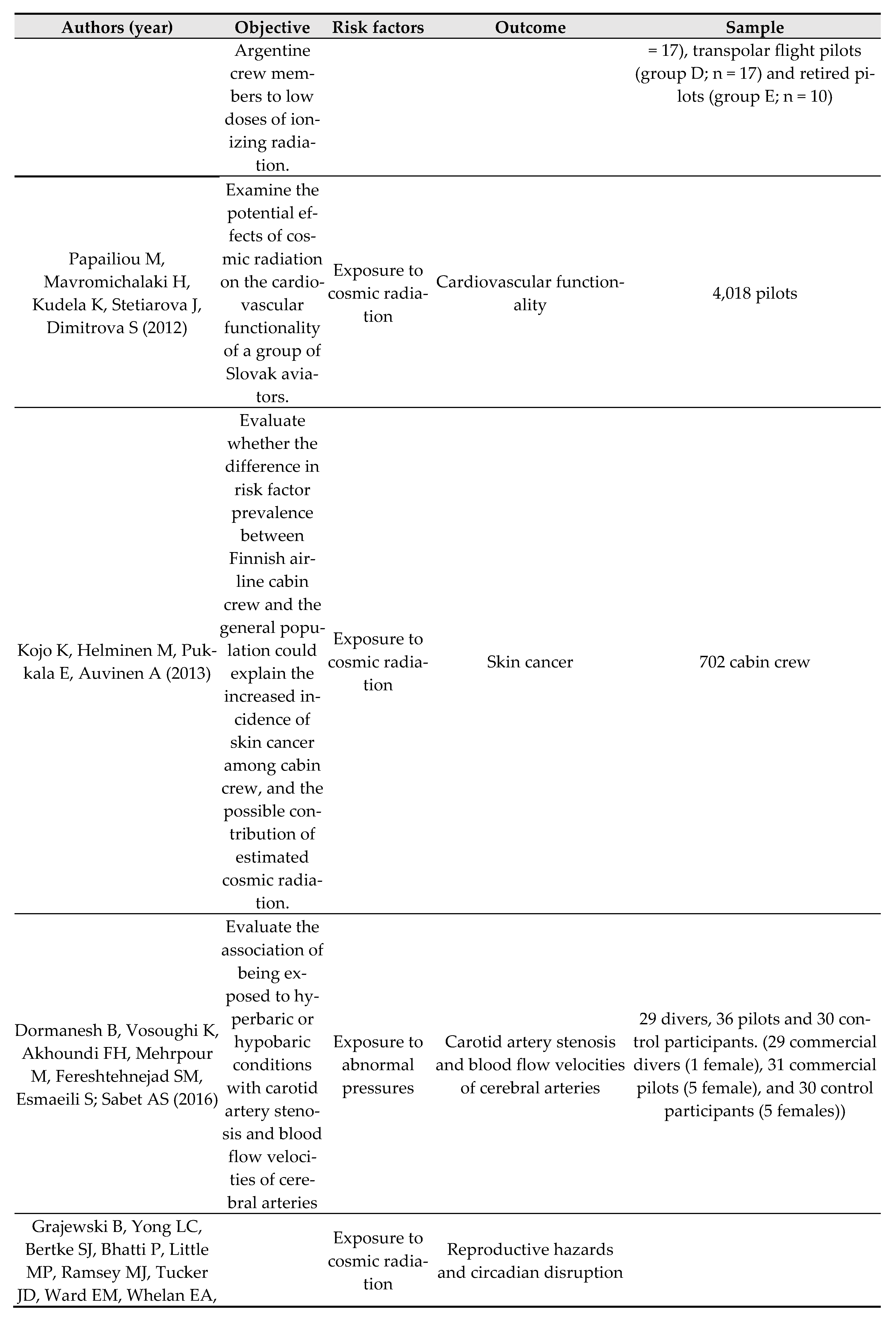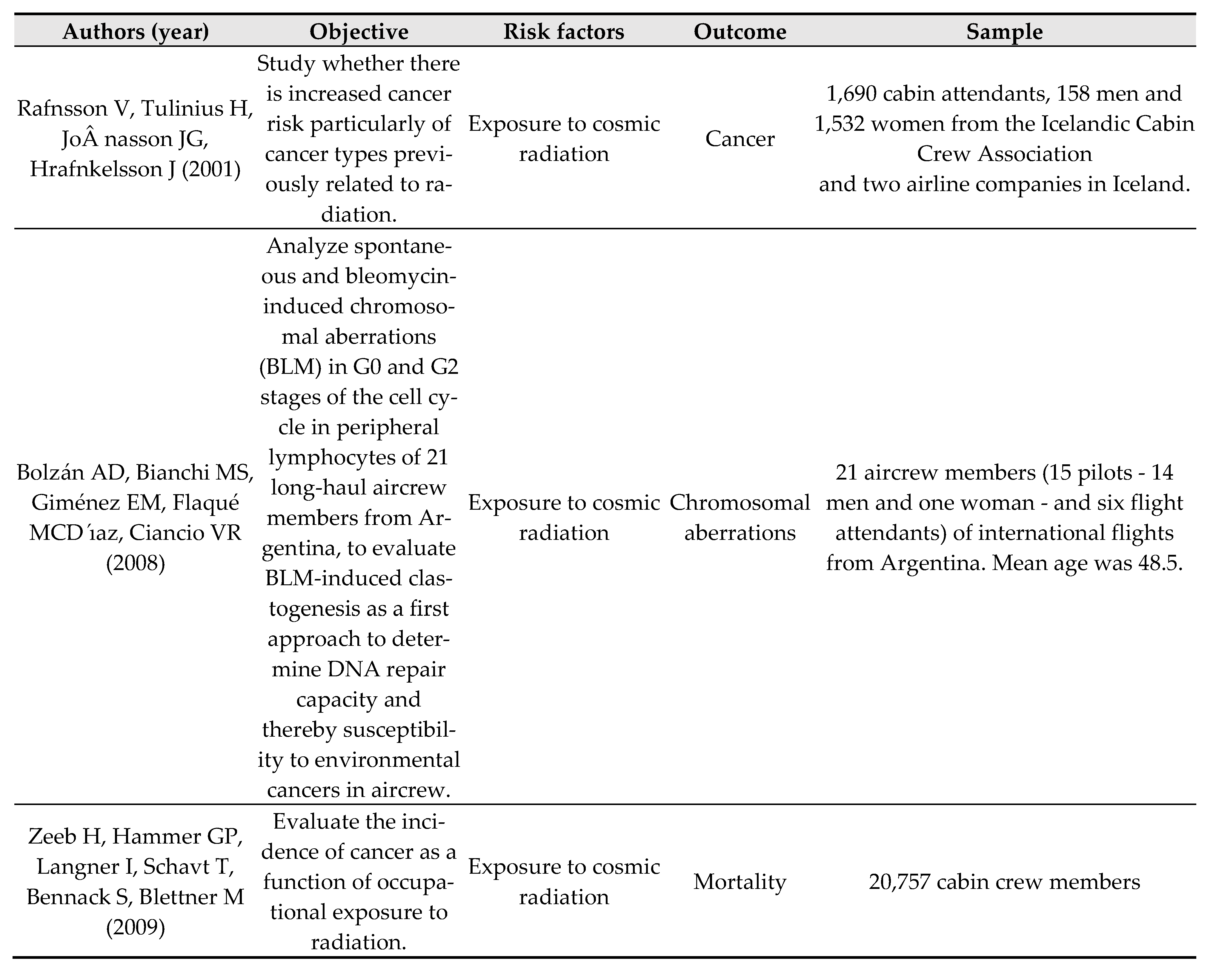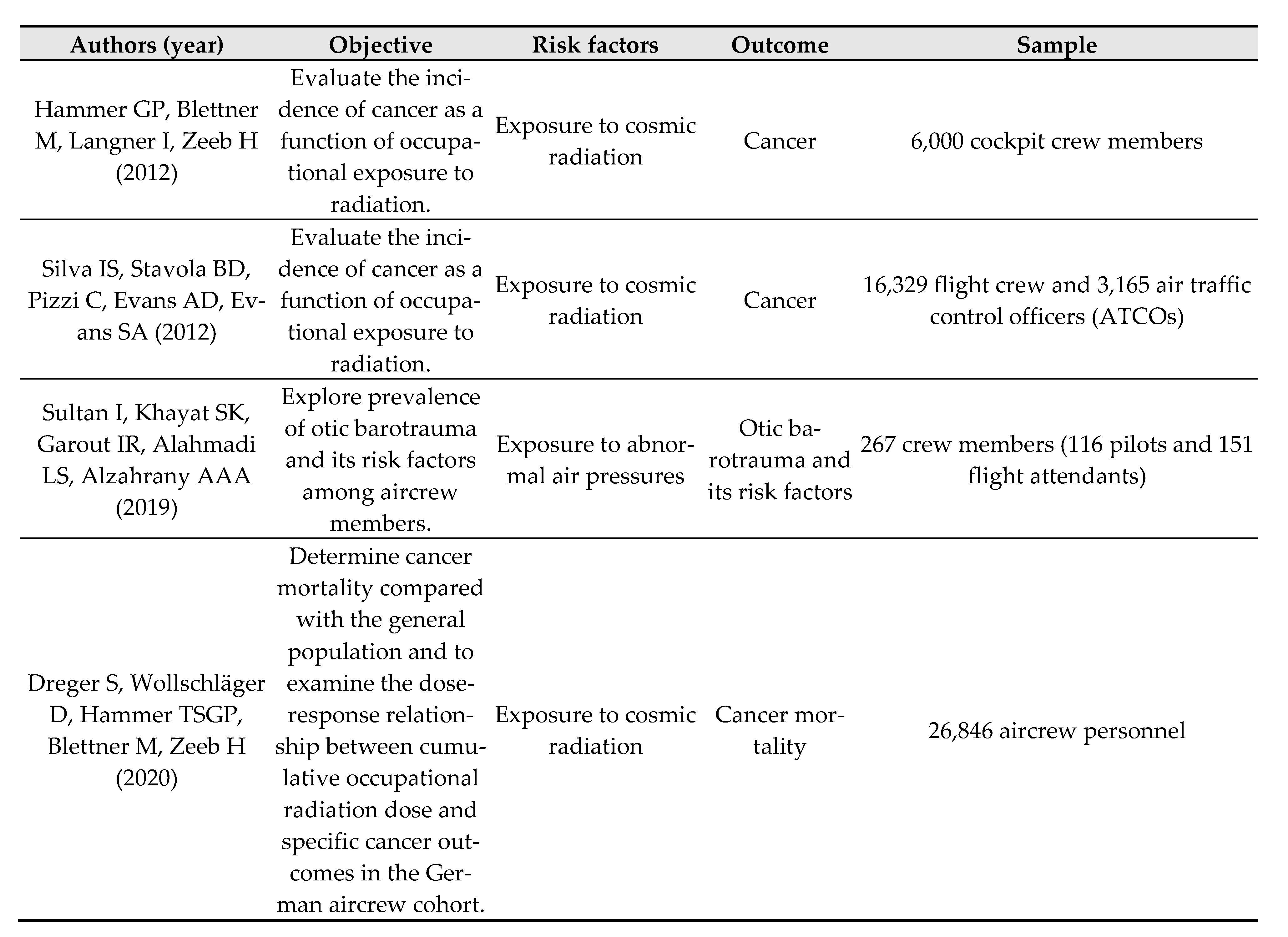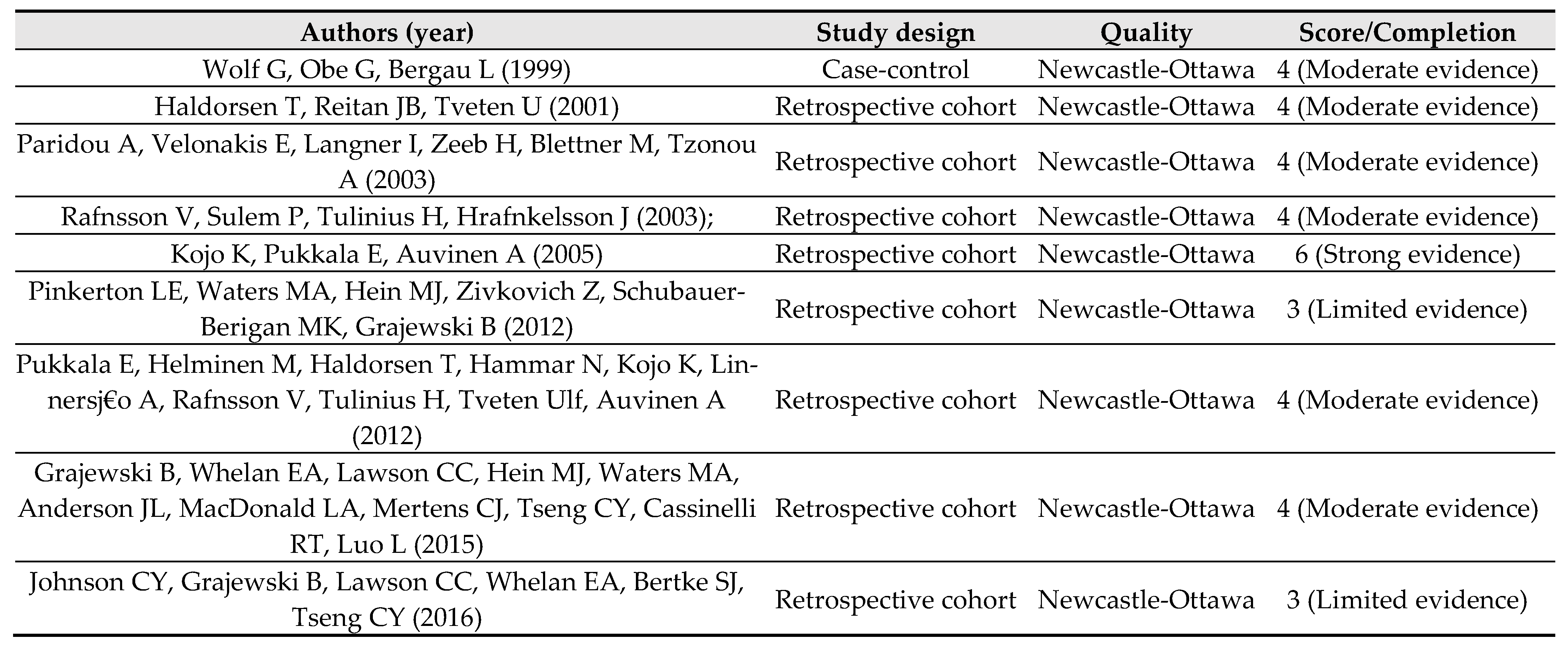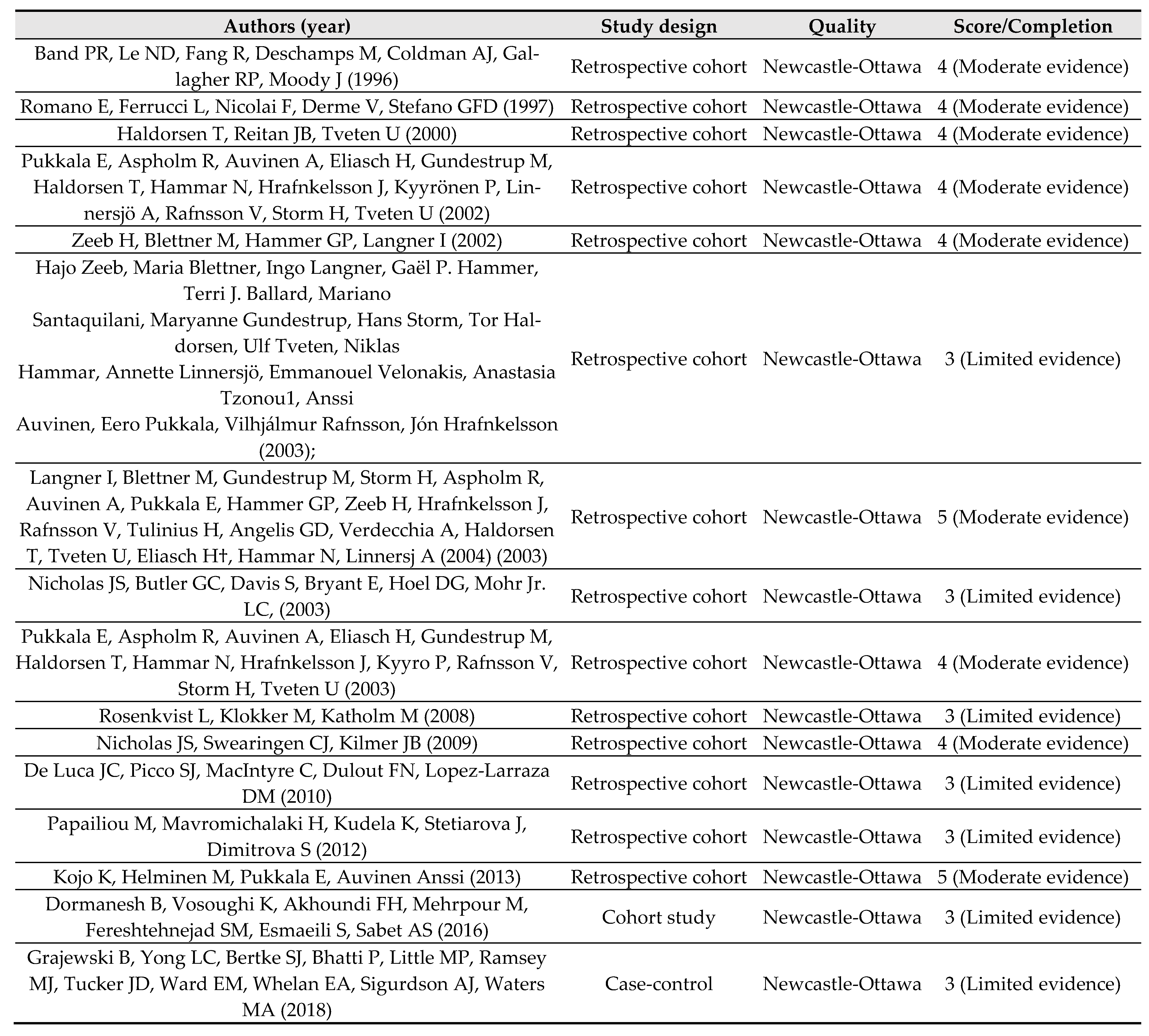1. Introduction
The occupational activity of aircrew has specific characteristics inherent to the job. The physical risk agents that potentially affect these workers include air pressure, noise, vibration, ionizing radiation, and temperature [
1]. The aviation environment presents numerous challenges to humans, such as the lack of time to adapt to rapid hypobaric changes. In this context, aviation medicine should be preventive in nature and recognized as a public health issue.
Sporadic or prolonged exposure to these agents can damage the health of workers. One of the most common health problems associated with the aviation profession is middle-ear barotrauma, defined as inflammation of the tympanic membrane and middle-ear cavity due to differences in pressure between the cavity and external atmospheric pressure, a phenomenon also associated with diving or hyperbaric oxygen therapy [
2,
3].
Changes in atmospheric pressure in the cabin can lead to barotrauma, uni- or bi-lateral, in the first few years on the job [
4]. Because of this risk, crew members are advised not to fly when exhibiting upper respiratory tract symptoms [
5]. It is important to highlight that in 95.4% of barotrauma cases, the events occurred at the time of descent of the aircraft from cruising to landing altitudes [
6].
In addition to the possibility of barotrauma [
7], hypobarism can decrease and compromise mental capacity, including judgment, memory and performance of fine motor movements [
8].
Another pressure-related problem is hypoxia, which occurs during cabin decompression. The low oxygen concentrations can lead to drowsiness, headache, dizziness, visual changes, cyanosis, hilarity, euphoria, convulsions, spasms [
9] and altered cerebral white matter [
10,
11].
In addition to the implications of pressure, there are potential problems associated with ionizing radiation [
12], which pose an additional risk to the health of aircraft crew members [
13]. The effects of this agent include gene mutations, breakdown of the DNA molecule and generation of free radicals, which increase the risk of cancer in exposed individuals and their offspring, while also promoting cardiovascular disorders, cataracts and genetic alterations [
14].
This topic has attracted attention from Brazilian trade unions, universities, and researchers, representing a new field of research with multiple facets and possibilities. Although the subject has been addressed through interdisciplinary approaches from different areas of science, such as engineering and health, studies exploring the occupational impact of physical agents (especially ionizing radiation and hypobaric pressure) on Brazilian aircrew are still scarce and therefore deserve attention.
This dearth of investigations prompted the present study whose objective was to analyze and elucidate the main occupational risks to pilots and flight attendants from exposure to physical agents in the work environment. This is the first study of its kind identifying, categorizing and analyzing the current evidence reported in the available literature on the risk of physical agents among this category of workers. This study also serves to highlight the lack of Brazilian research in this population.
2. Materials and Methods
This theoretical study involved the application of the technical procedure for a systematic literature review (SLR). This technique was used to identify, evaluate, and interpret the relevant research on occupational physical agents present in civil aviation using a defined methodological sequence that allows knowledge to be pooled and built [
16,
17].
The design of this SLR was devised according to the guidelines of the Preferred Reporting Items for Systematic Reviews and Meta-analyses (PRISMA) statement [
18] and was registered on the PROSPERO platform (number 240012). Given the study was a literature review, submission to the Research Ethics Committee for prior approval was waived.
The SLR comprises a sequence of three stages: planning, conducting and presenting the review, each of which entails its respective actions (
Figure 1).
2.1. Bibliometric mapping
The VOSviewer software was employed (using terms and keywords) to map the main activities in the area of study (Occupational Risks x Aircrew) and visualize bibliometric maps from the review.
The resulting data were analyzed using VOSviewer software to build relationship networks of terms from the Web of Science, Scopus, PubMed, and Cochrane databases used in the systematic literature review.
2.2. Search strategy
The PICo strategy for non-clinical research was used to construct the research question (
Table 1), namely: Are the physical agents of ionizing and cosmic radiation, abnormal air pressure and noise occupational risk factors for commercial aircrew?
The planning phase began based on a review of possible occupational risks involving aircrew to gain greater familiarity with the theme addressed and better define the research problem. In this phase, the feasibility and necessity of this study were also confirmed, mainly by drawing on previous reports [
4,
11,
12] which served as the main theoretical basis of the investigation.
The searches were carried out on the Web of Science, Scopus, Pub Med, and Cochrane databases from February to May 2021, chosen for their interdisciplinary nature and for constituting the largest databases available. The keywords were defined according to the Medical Subject Headings (MeSH).
Initially, a search using the key words "Risk Factors" and "Aircrew" was conducted on the Web of Science to identify the publication period to be considered (
Figure 2).
The first publications on the subject began around 1992 and, therefore, the period from 1990 to 2021 was adopted for searches (
Figure 2).
The main areas of knowledge related to the theme, obtained using the search terms "Risk Factors" and "Aircrew,” are described in
Figure 3. All relevant publications were in English and, therefore, this language was established as a filter for the search.
The occupational health area had the highest number of studies on the occupational risks of aircrew.
Based on the definitions of the terms to be searched, the following combinations of key words were obtained, resulting in 24 permutations (
Figure 4):
2.3. Eligibility criteria
Potentially relevant studies were selected by two independent reviewers according to the following inclusion criteria:1) articles in Portuguese and English; 2) articles available in full; 3) only studies with observational design (cross-sectional, cohort, case-control) and interventions; 4) articles published since 1990; 5) studies involving men and women of any age group; 6) studies evaluating the main occupational physical risks; 7) peer-reviewed articles; and 8) only investigation of civil aviation.
Studies whose design type was clinical trials, ecological studies, review studies or qualitative studies were excluded, as were studies involving retired professionals, studies with different objectives from those of the present review, studies involving helicopter pilots, abstracts, technical reports, oral communications, letters to the Editor, studies with simulated flights, and studies of military aircrew and helicopter studies.
The initial selection of articles was performed independently by reading of titles and abstracts. Subsequently, both reviewers read the full texts of the articles that met the inclusion criteria. Any disagreements regarding the eligibility of the articles was settled by consulting a third researcher. The number of studies included and excluded in the different phases of the systematic review is presented in the PRISMA flowchart (Table 7).
2.4. Article data extraction
Data extraction included the following variables: author, year, study design, sample, objective, and main study results. Microsoft Office Excel 2021® was used to tabulate the parameters extracted.
2.5. Quality assessment
To evaluate the risk of bias and methodological quality of the studies reviewed, two tools were used: the Newcastle-Ottawa Scale [
19] for cohort and case-control studies, and the guidelines of Loney et al. (1998) for cross-sectional studies.
As described in the Newcastle-Ottawa Scale, the methodological quality score of cohort and case-control studies was calculated based on three components (ranging from 0 to 9 points): 1) group selection (0–4 points); 2) quality of adjustment for confounders (0–2 points); and 3) exposure evaluation after outcome (0–3 points) [
19]. Cross-sectional studies, in turn, were evaluated using Loney's criterion, yielding a range of 0 to 8 points, with the highest scores indicating higher methodological quality. The score is obtained from the eight questions that make up the scale, and each of the questions evaluated is assigned one or zero according to the adequacy of the methods and presentation of the results [
20].
3. Results
The search strategy led to the identification of 3,938 articles. A total of 1,542 duplicate articles were removed. Of the remaining studies, 1,288were selected for title and abstract screening, of which 1,181 were excluded for not meeting the inclusion criteria.
Of the 107 remaining articles evaluated, 72 were excluded for not meeting the inclusion criteria. Therefore, 35 articles were included in this systematic review. A consensus between the two reviewers was reached for all of the articles included (
Figure 5).
3.1. Bibliometric analysis
Graphs were generated based on the search terms (
Figure 4). The two analyses were combined by constructing two distinct maps (co-authorship and keywords). Thus, the keywords used with greater frequency and intensity, as well as the co-authorship relationships were analyzed.
Using the VOSviewer software, the main words in the titles and abstracts of the articles in the selected databases (Web of Science, SCOPUS, PubMed, and Cochrane) were detected. Words were detected based on a co-occurrence network, as shown in
Figure 6. Seven clusters were formed using the VOSviewer grouping technique. The words presented in each cluster were related to different areas of research.
The colors shown in
Figure 6 are random, serving to distinguish the s-work groups. Each circle represents a term, with names truncated by the software to avoid visual overlaps [
21]. Circle size reflects the number of occurrences of a term. The words present in the clusters have a direct relationship with each other, corresponding to their separation factors. The size of each word in the cluster is related to its weight, i.e. co-occurrence in publications.
The map highlights the terms "mortality,” "cancer,” "cosmic radiation,” "aviation,” "altitude,” "risk" and "pilots" as being the main concepts of established relationships.
The last analysis in VOSviewer sought to identify the networks of co-authorship among authors related to the topic, i.e. the inter-relationship of the authors (
Figure 7).
The analysis indicated the existence of 125 clusters or groups of authors with affinity in their research. However, 12 of the 125 groups had a greater influence (
Figure 8).
3.2. Where were studies conducted? What is Brazil's output?
Figure 9 shows the origins of the articles reviewed. Most of the investigations were carried out in the United States (29%), followed by Germany (17%) and Finland (17%). No public Brazilian research was identified, evidencing the need for more local studies.
Among the studies involving flight attendants published between 1999 and 2018, 15% were conducted in the last five years (2017–2021) (
Chart 1). In studies of pilots published between 1996 and 2018, only 7% date back to the last five years (
Chart 2). Finally, the studies involving both flight attendants and pilots were published between 2001 and 2020, 28% of which were carried out in the last five years (
Chart 3). In short, of the total studies reviewed, 29% were conducted between 2017 and 2020.
3.2.1. Studies involving flight attendants
The analysis of the main results found in studies of flight attendants showed that exposure to cosmic radiation was the leading risk factor. Given this risk factor, cancer was the main outcome (
Chart 1).
Three studies [
22,
23,
24] investigated whether exposure to cosmic radiation caused biological effects in flight attendants. The case-control study failed to identify biological alterations relative to the rest of the population (
Chart 1).
The study by Haldorsen et al. [
25] evaluated the incidence of cancer as a function of cosmic radiation in 3,693 cabin attendants. Among women, a higher incidence of breast cancer was observed, while among men, a higher risk of cancer was observed in the upper respiratory and gastric tract. Additionally, the study by Pukkala et al. [
26] of 8,507 female and 1,559 male airline cabin attendants found significant excesses in skin melanoma among men. The study by Mcneely [
27] observed an association between job tenure and breast cancer among women who had three children or more children (
Chart 1).
Rafnsson et al. [
28] studied 1,532 flight attendants and found that length of employment was associated with risk of breast cancer. However, the study by Paridou et al. [
29] failed to identify a pattern of cancer with duration of employment in an analysis of 1,835 flight attendants. Three studies [
30,
31,
32] found no statistically significant association between cumulative radiation dose and cancer, whereas family history of cancer had a stronger influence on occurrence of the disease (
Chart 1).
Lastly, in a cohort study [
33] of2,273 flight attendants investigating whether exposure to cosmic radiation was associated with cases of miscarriage concluded that the risk of cases was not increased compared with the general population (
Chart 1).
3.2.2. Studies involving pilots
The most investigated themes among pilots were cancer due to exposure to cosmic radiation, and barotrauma due to exposure to abnormal air pressure (
Chart 2).
The study of Band et al.[
34] evaluated the incidence of cancer as a function of occupational radiation exposure in 2,740 pilots. The authors concluded that long-term follow-up is required for a more in-depth evaluation of cancer incidence in this population. In the study by Haldorsen et al. [
35] investigating 3,701 pilots, elevated risks were found for malignant melanoma and non-melanoma skin cancer and, according to 2 articles [
36,
37,
38], this risk can be increased due to the greater number of hours of long-haul flights. In addition to flying hours, the study by Langner et al. [
39] found that childhood sunburn and a family history of skin cancer were conditions that increased the risk of cancer (
Chart 2).
However, based on the results of the studies by [
40,
41], no cancer mortality risk was found to be substantially increased due to exposure to ionizing radiation compared to the rest of the population (
Chart 2).
Two studies [
42,
43] evaluated whether exposure to cosmic radiation contributes to an increase in chromosomal aberrations. The results confirmed this hypothesis; however, the authors highlighted the need for studies involving a larger number of participants. Complementing this research, Rosenkvist et al. [
44] studied 2,802 pilots to determine the frequency of translocations and insertions in the blood over the long-term with respect to radiation dose received. The results showed that mean number of translocations per cell was significantly higher among pilots than in controls (
Chart 2).
Dormanesh [
45] investigated 4,018 pilots and identified that cosmic radiation, in addition to the above-mentioned effects, can influence the diastolic and systolic blood pressures of these professionals (
Chart 2), thus altering cardiovascular functionality.
In addition to cosmic radiation, air pressure is another relevant factor. Two studies [
46,
47] evaluated the effects of exposure to abnormal pressures on pilots. The first [
46] identified several cases of barotrauma, mainly affecting the ear. The authors of the second study [
47] observed acceleration of carotid artery atherosclerosis in pilots (
Chart 2).
Based on the results of studies in pilots, the investigations analyzing exposure to cosmic radiation, although more numerous, are inconclusive on whether cancer risk is higher in pilots than in the rest of the population. By contrast, articles on exposure to abnormal pressures, albeit numbering only two, present evidence supporting damage caused to pilot health (
Chart 2).
3.2.3. Studies involving both attendants and pilots
In studies conducted with both flight attendants and pilots simultaneously, it was found that, similarly to the results of studies conducted solely with pilots, the risk factors associated with cosmic radiation and abnormal pressures stand out (
Chart 3).
One study [
48] identified an increased risk of cancer, especially for those who had a higher cosmic exposure at a young age and those hypersensitive to bleomycin [
49]. However, in several studies [
50,
51,
52], the authors failed to find a higher risk of cancer in this population, and were actually lower in some cases because the subjects did not present smoking-related cancer.
Regarding exposure to abnormal air pressure, one study [
50] explored the prevalence of otic barotrauma and its risk factors in crew members. The authors found that the risk of barotrauma in these professionals increased for individuals who were smokers, presented allergy, hormonal disorder and/or worked over 70 hours per month.
It is important to highlight that none of the studies included in this review evaluated ways of mitigating the risk factors investigated. The authors only presented suggestions on what can be done in an effort to minimize health risks, highlighting reducing consecutive working days and allowing longer rest time between work shifts, especially on long-haul flights.
3.2. Quality assessment of studies reviewed
Of the 35 articles reviewed, 12 were conducted in flight attendants (37.1%) only, 15 in pilots (42.9%), and seven evaluated both flight attendants and pilots concomitantly (20.0%) (Table 4). Of the 12 studies of flight attendants alone, 11 were cohort studies (91.7%) and 1 was a case-control study (8.3%). Only one of the cohort studies attained a score of 6 points, i.e., had strong evidence; nine scored 4 points, and two scored 3 points, indicating that most of the studies reviewed had moderate evidence (
Chart 4).
Of the studies conducted among pilots (n=16) only, the majority were retrospective (n=14, 87.5%). Of the 14 retrospective studies, nine scored 4 or 5 points, indicating moderate evidence; seven scored 4 points and two attained 3 points, suggesting moderate quality. Five scored only 3 points, indicating limited evidence. The cohort study (6.25%) and case-control study (6.25%) both scored 3 points, indicating limited evidence (
Chart 5).
In the case of the 7 studies involving both flight attendants and pilots concomitantly, the majority were retrospective cohort studies (85.7%). Of these cohort studies, 4 had moderate evidence, two scored 4 points, two 5 points, and two studies attained 3 points, indicating limited evidence. Only the cross-sectional study (14.3%) obtained a score of 5 points, indicating moderate quality (
Chart 6).
4. Discussion
The most prevalent physical health risk factors among flight attendants and pilots were ionizing radiation and abnormal air pressure. Secondary to these risk factors, the most prevalent health problems associated with ionizing radiation in the articles analyzed were problems related to cancer [
25,
26,
27,
28,
35,
39] , risks in the reproductive system [
33], and cardiovascular functionalities [
45].
However, most authors stated the p effects in aircrew were similar to those in the non-exposed general population [
29,
30,
31,
36,
38,
41,
51,
53]. In order to gain a better understanding of the risks, long-term monitoring of crew members [
33] and assessment of a larger number of participants [
42] are required.
For exposure to abnormal air pressure, the most prevalent outcomes were barotrauma [
46,
54] and changes in blood pressure and cerebral blood flow [
47]. This change in blood pressure can be caused by hypoxia, characterized by low oxygen concentrations in cellular tissues. In aviation, this symptom is caused when the altitude increases, accompanied by decrease in atmospheric pressure and consequent decrease in partial oxygen pressure, known in this case as Hypoxic Hypoxia [
55].
Although the percentage of oxygen in the atmosphere is constant, the decrease in partial pressure reduces the differential pressure between the blood flow in the pulmonary alveolus and atmospheric oxygen, thus hindering gas exchange between them.
Regarding the quality of the studies analyzed in the present review, most were cohort studies with moderate level of evidence (63%), i.e. there was moderate confidence in the estimated effect. However, these studies have made important contributions to the understanding of the main risk factors for aircrew health.
The absence of Brazilian studies in the articles retrieved is also noteworthy. This highlights the need for further studies to address the issue of occupational health among Brazilian aircrew and for further discussion on the development of public policies in this sector, especially given that Brazil has one of the largest aircraft fleets in the world.
However, the current reality is that aircrew health protection policies remain largely ineffective [
55], failing to consider, for example, exposure to agents such as hypobaric pressure. Therefore, exposure to physical risk agents may promote the onset and/or worsening of diseases [
15] which, over time, can become chronic, as documented in previous Brazilian studies [
12], some of which are centered on aerospace medicine [
5].
The study by Loterio et al. [
7] underscores the need to restructure the working conditions offered to Brazilian aircrew.
5. Conclusions
This systematic review explored the available literature on occupational risks arising from physical agents in both pilots and flight attendants. Many studies have reported effects on cancer incidence of exposure to ionizing radiation. However, the results obtained in the studies reviewed showed no significant difference between cancer cases in aircrew and the general population.
Although the minority, studies on the risks of exposure to abnormal air pressures, especially hypobarics, have yielded relevant findings. Hypobaric pressure may lead to ear and otic barotrauma and acceleration of carotid artery atherosclerosis. but there is a dearth of research examining the phenomenon.
Regarding quality, most studies on risk factors for aircrew were rated as being of moderate or limited methodological and evidence quality. The main limitations pointed out in the studies were the short analysis period and the low number of participants in the research.
No Brazilian articles were found among the studies reviewed, reinforcing the need for national studies investigating the specificities of work in Brazil, since characteristics inherent to the country such as climate, labor laws, etc. can influence working conditions, differentiating them from aircrew in other locations.
There is a need for further research to further and deepen scientific knowledge on the subject. This research should directly involve professionals in the area and adopt a quantitative approach to yield relevant statistical data. Future studies could entail an experimental approach and field research, for example, including medical examinations that monitor health problems and confirm their causality.
Thus, further studies should be conducted on occupational risks, preferably with longitudinal designs, so as to provide more robust evidence on the risk factors linked to physical agents and evaluate ways of reducing these, thereby enhancing quality of life in the workplace for this group of Brazilian professionals.
Chart 7.
PRISMA checklist.
Chart 7.
PRISMA checklist.
Author Contributions
Conceptualization, A.CR., E.A.d.S.e.B., P.C.V.G. and C.A.S.; validation, A.C.R., E.C.M., E.A.d.S.e.B., M.S.G.F. , R.C.R., P.C.V.G. and C.A.S.; investigation, A,C.R. and E.C.M.; resources, A,C.R. and E.C.M.; data curation, A,C.R. and E.C.M.; writing—original draft preparation, A.C.R.; writing—review and editing, A.C.R., E.C.M., E.A.d.S.e.B., M.S.G.F. , R.C.R., P.C.V.G. and C.A.S.; visualization, A.C.R., E.C.M., E.A.d.S.e.B., M.S.G.F. , R.C.R., P.C.V.G. and C.A.S.; supervision, C.A.S.; project administration, A.C.R., E.C.M., E.A.d.S.e.B., M.S.G.F. , R.C.R., P.C.V.G. and C.A.S. All authors have read and agreed to the published version of the manuscript.
Institutional Review Board Statement
Not applicable
References
- Mello, D.C.B. de Comissárias de Voo: Um Olhar Sobre a Relação Entre Os Tempos de Trabalho e Da Vida Familiar, Escola Nacional de Saúde Pública Sergio Arouca, 2009.
- Landolfi, A.; Torchia, F.; Autore, A.; Appiani, M.C.; Morgagni, F.; Appiani, G.C. Acute Otitic Barotrauma during Hypobaric Chamber Training: Prevalence and Prevention. Aviat. Sp. Environ. Med. 2009, 80, 1059–1062. [Google Scholar] [CrossRef] [PubMed]
- Mitchell-Innes, A.; Young, E.; Vasiljevic, A.; Rashid, M. Air Travellers’ Awareness of the Preventability of Otic Barotrauma. J. Laryngol. Otol. 2014, 128, 494–498. [Google Scholar] [CrossRef] [PubMed]
- Athayde, C.M.; Silva, M.M. e; Ferreira, R.D.; Soares, J.F.R.; Andrade, W.T.L. de Impacto Do Ruído Dos Aeroportos e Aeronaves Para a Saúde Dos Aeronautas. Brazilian J. Heal. Rev. Síndrome 2020, 2, 2205. [Google Scholar] [CrossRef]
- Bastos, A.G.D.; Souza, A.T.C.L. de Barotite Média Em Tripulantes Da Aviação Civil. Rev. Bras. Otorrinolaringol. 2004, 70, 102–105. [Google Scholar] [CrossRef]
- Rodrigues, C. de L.P. Barotraumatismo Em Pessoal Navegante de Cabine: CAUSAS, CONSEQUÊNCIAS E MEDIDAS PREVENTIVAS, UNIVERSIDADE DOS AÇORES, 2012.
- Loterio, C.P. Ministério Da Saúde, Fundação Oswaldo Cruz, 1999.
- Melo, M.F.S. de; Silvany Neto, A.M. Perfil de Morbidade, Aspectos Ergonômicos e Psicossociais, Fadiga e Perturbação Do Ciclo Circadiano de Pilotos de Aviação Comercial: Uma Revisão Narrativa. Rev. Baiana Saúde Pública 2012, 36, 683–698. [Google Scholar] [CrossRef]
- Tavares, C.M.C. Percepção de Riscos Dos Tripulantes de Cabina Da SATA Air Açores, Universidade dos Açores: Ponta Delgada, 2011.
- Magalhães, J.; Duarte, J.; Ascensão, A.; Oliveira, J.; Soares, J. O Desafio Da Altitude. Uma Perspectiva Fisiológica. Rev. Port. Ciências do Desporto 2002, 2002, 81–91. [Google Scholar] [CrossRef]
- Rocha, L.H.N. Desempenho de Pilotos e Segurança de Voo : O Caso Da Hipoxia Em Aviação Desportiva, UNIVERSIDADE DA BEIRA INTERIOR, 2011.
- Leite, M.V.N. Radiação Ionizante - Exposição Dos Aeronautas Na Aviação Comercial Brasileira E Os Atuais Aspectos Normativos Locais: Uma Análise Comparativa Às Normas E Práticas Internacionais, Universidade do Sul de Santa Catarina, 2020.
- Ruas, A.C. O Tripulante de Aeronaves e a Radiação Ionizante; Edição do Autor: São Paulo, 2019; ISBN 978-65-902085-0-7. [Google Scholar]
- Copeland, K.; Friedberg, W. Ionizing Radiation and Radiation Safety in Aerospace Environments Final Report; Oklahoma, 2021. [Google Scholar]
- ATHAYDE, C.M.; AZEVEDO, I.G.D.; ANDRADE, W.T.L. Níveis de Ruído Interno de Aeronaves Domésticas. In Proceedings of the 30o Encontro Internacional de Audiologia; Academia Brasileira de Audiologia, Bauru; 2015. [Google Scholar]
- Kitchenham, B.; Charters, S. Guidelines for Performing Systematic Literature Reviews in Software Engineering; Durham, 2007. [Google Scholar]
- Greenhalgh, T. How to Read a Paper: Papers That Summarise Other Papers (Systematic Reviews and Meta-Analyses). BMJ 1997, 315, 672–675. [Google Scholar] [CrossRef]
- Moher, D.; Shamseer, L.; Clarke, M.; Ghersi, D.; Liberati, A.; Petticrew, M.; Shekelle, P.; Stewart, L.A.S. Preferred Reporting Items for Systematic Review and Meta-Analysis Protocols (Prisma-p) 2015 Statement. Japanese Pharmacol. Ther. 2019, 47, 1177–1185. [Google Scholar] [CrossRef]
- Wells, G.A.; Shea, B.; Wells, D.; Peterson, J.; Welch, V.; Losos, M.; Tugwell, P. The Newcastle-Ottawa Scale (NOS) for Assessing the Quality of Nonrandomised Studies in Meta-Analyses Available online:. Available online: http://www.ohri.ca/programs/clinical_epidemiology/oxford.asp (accessed on 13 January 2022).
- Loney, P.L.; Chambers, L.W.; Bennett, K.J.; Roberts, J.G.; Stratford, P.W. Critical Appraisal of the Health Research Literature: Prevalence or Incidence of a Health Problem. Chronic Dis. Can. 1998, 30, 170–176. [Google Scholar]
- Correa, S.R.; Machado, R.L. ANÁLISE BIBLIOMÉTRICA DE PUBLICAÇÕES NA TEMÁTICA DO BIG DATA UTILIZANDO O VOSviewer. Rev. Gestão, Inovação e Negócios 2018, 4, 01–12. [Google Scholar] [CrossRef]
- Wolf, G.; Obe, G.; Bergau, L. Cytogenetic Investigations in Flight Personnel. Radiat. Prot. Dosimetry 1999, 86, 275–278. [Google Scholar] [CrossRef] [PubMed]
- Schubauer-Berigan, M.K.; Anderson, J.L.; Hein, M.J.; Little, M.P.; Sigurdson, A.J.; Pinkerton, L.E. Breast Cancer Incidence in a Cohort of U. S. Flight Attendants. Am. J. Ind. Med. 2015, 58, 252–266. [Google Scholar] [CrossRef]
- Pinkerton, L.E.; Waters, M.A.; Hein, M.J.; Zivkovich, Z.; Schubauer-Berigan, M.K.; Grajewski, B. Cause-Specific Mortality among a Cohort of U. S. Flight Attendants. Am. J. Ind. Med. 2012, 55, 25–36. [Google Scholar] [CrossRef]
- Haldorsen, T.; Reitan, J.B.; Tveten, U. Cancer Incidence among Norwegian Airline Cabin Attendants. Int. J. Epidemiol. 2001, 30, 825–830. [Google Scholar] [CrossRef] [PubMed]
- Pukkala, E.; Helminen, M.; Haldorsen, T.; Hammar, N.; Kojo, K.; Linnersjö, A.; Rafnsson, V.; Tulinius, H.; Tveten, U.; Auvinen, A. Cancer Incidence among Nordic Airline Cabin Crew. Int. J. Cancer 2012, 131, 2886–2897. [Google Scholar] [CrossRef]
- McNeely, E.; Mordukhovich, I.; Staffa, S.; Tideman, S.; Gale, S.; Coull, B. Cancer Prevalence among Flight Attendants Compared to the General Population. Environ. Heal. A Glob. Access Sci. Source 2018, 17, 1–9. [Google Scholar] [CrossRef] [PubMed]
- Rafnsson, V.; Sulem, P.; Tulinius, H.; Hrafnkelsson, J. Breast Cancer Risk in Airline Cabin Attendants: A Nested Case-Control Study in Iceland. Occup. Environ. Med. 2003, 60, 807–809. [Google Scholar] [CrossRef]
- Paridou, A.; Velonakis, E.; Langner, I.; Zeeb, H.; Blettner, M.; Tzonou, A. Mortality among Pilots and Cabin Crew in Greece, 1990-1997. Int. J. Epidemiol. 2003, 32, 244–247. [Google Scholar] [CrossRef]
- Kojo, K.; Pukkala, E.; Auvinen, A. Breast Cancer Risk among Finnish Cabin Attendants: A Nested Case-Control Study. Occup. Environ. Med. 2005, 62, 488–493. [Google Scholar] [CrossRef]
- Pinkerton, L.E.; Hein, M.J.; Anderson, J.L.; Little, M.P.; Sigurdson, A.J.; Schubauer-Berigan, M.K. Breast Cancer Incidence among Female Flight Attendants: Exposure–Response Analyses. Scand. J. Work. Environ. Heal. 2016, 42, 538–546. [Google Scholar] [CrossRef] [PubMed]
- Pinkerton, L.E.; Hein, M.J.; Anderson, J.L.; Christianson, A.; Little, M.P.; Sigurdson, A.J.; Schubauer-Berigan, M.K. Melanoma, Thyroid Cancer, and Gynecologic Cancers in a Cohort of Female Flight Attendants. Am. J. Ind. Med. 2018, 61, 572–581. [Google Scholar] [CrossRef]
- Grajewski, B.; Whelan, E.A.; Lawson, C.C.; Hein, M.J.; Waters, M.A.; Anderson, J.L.; MacDonald, L.A.; Mertens, C.J.; Tseng, C.-Y.; Cassinelli II, R.T.; et al. Miscarriage Among Flight Attendants. EPIDEMIOLOGY 2015, 26, 192–203. [Google Scholar] [CrossRef] [PubMed]
- Band, P.R.; Le, N.D.; Fang, R.; Deschamps, M.; Goldman, A.J.; Gallagher, R.P.; Moody, J. Cohort Study of Air Canada Pilots: Mortality, Cancer Incidence, and Leukemia Risk. Am. J. Epidemiol. 1996, 143, 137–143. [Google Scholar] [CrossRef] [PubMed]
- Haldorsen, T.; Reitan, J.B.; Tveten, U. Cancer Incidence among Norwegian Airline Pilots. Scand. J. Work. Environ. Heal. 2000, 26, 106–111. [Google Scholar] [CrossRef] [PubMed]
- Pukkala, E.; Aspholm, R.; Auvinen, A.; Eliasch, H.; Gundestrup, M.; Haldorsen, T.; Hammar, N.; Hrafnkelsson, J.; Kyyrönen, P.; Linnersjö, A.; et al. Incidence of Cancer among Nordic Airline Pilots over Five Decades: Occupational Cohort Study. BMJ 2002, 325, 1–5. [Google Scholar] [CrossRef]
- Pukkala, E.; Aspholm, R.; Auvinen, A.; Eliasch, H.; Gundestrup, M.; Haldorsen, T.; Hammar, N.; Hrafnkelsson, J.; Kyyrönen, P.; Linnersjö, A.; et al. Cancer Incidence among 10,211 Airline Pilots: A Nordic Study. Aviat. Sp. Environ. Med. 2003, 74, 699–706. [Google Scholar]
- Nicholas, J.S.; Swearingen, C.J.; Kilmer, J.B. Predictors of Skin Cancer in Commercial Airline Pilots. Occup. Med. (Chic. Ill). 2009, 59, 434–436. [Google Scholar] [CrossRef]
- Langner, I.; Blettner, M.; Gundestrup, M.; Storm, H.; Aspholm, R.; Auvinen, A.; Pukkala, E.; Hammer, G.P.; Zeeb, H.; Hrafnkelsson, J.; et al. Cosmic Radiation and Cancer Mortality among Airline Pilots: Results from a European Cohort Study (ESCAPE). Radiat Env. Biophys 2004, 247–256. [Google Scholar] [CrossRef] [PubMed]
- Kojo, K.; Helminen, M.; Pukkala, E.; Auvinen, A. Risk Factors for Skin Cancer among Finnish Airline Cabin Crew. Ann. Occup. Hyg. 2013, 57, 695–704. [Google Scholar] [CrossRef]
- Romano, E.; Ferrucci, L.; Nicolai, F.; Derme, V.; De Stefano, G.F. Increase of Chromosomal Aberrations Induced by Ionising Radiation in Peripheral Blood Lymphocytes of Civil Aviation Pilots and Crew Members. Mutat. Res. - Fundam. Mol. Mech. Mutagen. 1997, 377, 89–93. [Google Scholar] [CrossRef]
- Luca, J.C. De; Picco, S.J.; Macintyre, C.; Dulout, F.N.; Lopez-larraza, D.M. The Prevalence of Chromosomal Aberrations in Argentine Air Crew Members. Arch. Environ. Occup. Heal. ISSN 2010, 8244. [Google Scholar] [CrossRef]
- Nicholas, J.S.; Butler, G.C.; Davis, S.; Bryant, E.; Hoel, D.G.; Mohr, L.C. Stable Chromosome Aberrations and Ionizing Radiation in Airline Pilots. Aviat. Sp. Environ. Med. 2003, 74, 953–956. [Google Scholar]
- Rosenkvist, L.; Klokker, M.; Katholm, M. Upper Respiratory Infections and Barotraumas in Commercial Pilots: A Retrospective Survey. Aviat. Sp. Environ. Med. 2008, 79, 960–963. [Google Scholar] [CrossRef] [PubMed]
- Dormanesh, B.; Vosoughi, K.; Akhoundi, F.H.; Mehrpour, M.; Fereshtehnejad, S.M.; Esmaeili, S.; Sabet, A.S. Carotid Duplex Ultrasound and Transcranial Doppler Findings in Commercial Divers and Pilots. Neurol. Sci. 2016, 37, 1911–1916. [Google Scholar] [CrossRef]
- Zeeb, H.; Blettner, M.; Langner, I. Cohort Mortality Study of German Cockpit Crew, 1960 –1997. EPIDEMIOLOGY 2002, 693–699. [Google Scholar] [CrossRef]
- Rafnsson, V.; Tulinius, H.; Jónasson, J.G.; Hrafnkelsson, J. Risk of Breast Cancer in Female Flight Attendants: A Population-Based Study (Iceland). Cancer Causes Control 2001, 12, 95–101. [Google Scholar] [CrossRef]
- Bolzán, A.D.; Bianchi, M.S.; Giménez, E.M.; Flaqué, M.C.D.; Ciancio, V.R. Analysis of Spontaneous and Bleomycin-Induced Chromosome Damage in Peripheral Lymphocytes of Long-Haul Aircrew Members from Argentina. Mutat. Res. - Fundam. Mol. Mech. Mutagen. 2008, 639, 64–79. [Google Scholar] [CrossRef] [PubMed]
- Hammer, G.P.; Blettner, M.; Langner, I.; Zeeb, H. Cosmic Radiation and Mortality from Cancer among Male German Airline Pilots: Extended Cohort Follow-Up. Eur. J. Epidemiol. 2012, 27, 419–429. [Google Scholar] [CrossRef]
- Silva, I. dos. S.; Stavola, B. de; Pizzi, C.; Evans, A.D.; Evans, S.A. Cancer Incidence in Professional Flight Crew and Air Traffic Control Officers: Disentangling the Effect of Occupational versus Lifestyle Exposures. Int. J. Cancer 2013, 132, 374–384. [Google Scholar] [CrossRef] [PubMed]
- Dreger, S.; Wollschläger, D.; Schafft, T.; Hammer, G.P.; Blettner, M.; Zeeb, H. Cohort Study of Occupational Cosmic Radiation Dose and Cancer Mortality in German Aircrew, 1960-2014. Occup. Environ. Med. 2020, 77, 285–291. [Google Scholar] [CrossRef] [PubMed]
- Zeeb, H.; Hammer, G.P.; Langner, I.; Scha, T.; Sabrina, V.; Maria, B. Cancer Mortality among German Aircrew : Second Follow-Up. Radiat Env. Biophys 2009, 187–194. [Google Scholar] [CrossRef]
- Johnson, C.Y.; Grajewski, B.; Lawson, C.C.; Whelan, E.A.; Bertke, S.J.; Tseng, C.Y. Occupational Risk Factors for Endometriosis in a Cohort of Flight Attendants. Scand. J. Work. Environ. Heal. 2016, 42, 52–60. [Google Scholar] [CrossRef]
- SULTAN, I.; KHALID KHAYAT, S.; REDHA GAROUT, I.; SHAKER ALAHMADI, L.; AHMAD ALI ALZAHRANY, A. The Prevalence and Risk Factors of Otic Barotrauma Among Aircrew Members. Int. J. Life Sci. Pharma Res. 2019, 9, 24–30. [Google Scholar] [CrossRef]
- Almeida, M. de F. A FISIOLOGIA NA ATIVIDADE AÉREA E OS POSSÍVEIS DANOS CAUSADOS AOS AERONAUTAS, UNIVERSIDADE DO SUL DE SANTA CATARINA, 2019.
|
Disclaimer/Publisher’s Note: The statements, opinions and data contained in all publications are solely those of the individual author(s) and contributor(s) and not of MDPI and/or the editor(s). MDPI and/or the editor(s) disclaim responsibility for any injury to people or property resulting from any ideas, methods, instructions or products referred to in the content. |
© 2023 by the authors. Licensee MDPI, Basel, Switzerland. This article is an open access article distributed under the terms and conditions of the Creative Commons Attribution (CC BY) license (http://creativecommons.org/licenses/by/4.0/).
